Comprehensive Evaluation of Agrivoltaics Research: Breadth, Depth, and Insights for Future Research
Abstract
1. Introduction
2. Materials and Methods
2.1. Literature Collection
2.2. Literature Screening
2.3. Literature Categorization
2.3.1. Data Collection and Analysis
- Field Data: A publication was tagged as containing field data if it involved the collection and reporting of quantitative or qualitative measurements or responses from an agrivoltaic system or stakeholders, respectively. For instance, soil moisture data collected from a field site or survey responses collected from farmers would qualify a study as having field data.
- Modeled Data: Studies that employed computational, statistical, or analytical models to simulate agrivoltaic processes or predict outcomes, or generated data rather than making real-world measurements, were categorized as having modeled data. For instance, soil moisture data generated from a model that used real-world irradiance, temperature, and relative humidity data as inputs would qualify a study as having modeled data.
- Novel Data: A publication was designated as containing novel data analysis if it presented statistical evaluations, graphs, or new insights derived from original or secondary datasets. For instance, any publication presenting new field or modeled data qualified, and a publication that performed a new analysis on the data from five previously published papers would also qualify as novel data.
2.3.2. Agrivoltaic Activities
- Animal Grazing: Studies examining the integration of livestock (e.g., sheep, cattle, poultry) within solar arrays, including impacts on animal health, forage quality, and land management.
- Crop Production: Research focused on cultivating crops under or adjacent to solar panels, including studies on crop yields, physiology, and agronomic practices within agrivoltaic systems.
- Habitat/Ecovoltaics: Publications addressing the establishment of native vegetation, pollinator habitats, or other ecological functions within agrivoltaic systems, often linked to biodiversity conservation or apiaries.
- Greenhouse: Studies involving greenhouses with integrated solar panels or thermal solar systems, distinguishing them from open field agrivoltaic applications. Greenhouse studies would not be identified as Crop Production studies (vice versa) unless both activities were part of a single study.
- Crosscutting PV: Research on agrivoltaic technologies, system configurations, policy frameworks, deployment strategies, and interdisciplinary analyses that do not fit exclusively within one of the above categories.
2.3.3. Geographic Scope
- Global: Research with no specific geographic focus, including systematic reviews, meta-analyses, and global-scale modeling studies.
- Country-Level: Studies focused on a specific country, documenting field research, national policy analyses, or regionally specific modeling. The relevant country was recorded.
- State-Level (United States Only): For U.S.-based studies, state-specific data or analyses were documented to assess agrivoltaic implementation at the subnational level.
2.3.4. Categorization Hierarchy
- Categories: The broadest classification level, encompassing five overarching research domains:
- 1.1.
- Physical: Microclimatology, soil science, hydrology, and related environmental processes.
- 1.2.
- Technological: PV technologies, system configurations, and site suitability.
- 1.3.
- Biological: Plant science, livestock management, entomology, and ecosystem interactions.
- 1.4.
- Social: Research on policy, economics, market assessments, and stakeholder perspectives.
- 1.5.
- Crosscutting: Reviews, methodological studies, and interdisciplinary research spanning multiple domains.
- Topics: Within each category, research was further classified into specialized research topics, such as PV Performance, Crop Productivity, Soil Health, and Policy and Regulatory Issues.
- Sub-Topics: The most granular classification, sub-topics capture specific research areas frequently studied within each topic. For instance, the Microclimatology topic includes sub-topics such as Air Temperature, Relative Humidity, Wind and Airflow, Light and Shading, and PAR/PPFD.
2.4. Data Hosting and Analysis Methods
2.5. Methodological Limitations
3. Results
3.1. Agrivoltaic Activity
3.2. Document Type
3.3. Publications by Category, Topic, and Sub-Topic
3.3.1. Physical Category
Microclimatology Topic
Soil Topic
Hydrology Topic
3.3.2. Biological Category
Entomology Topic
Wildlife Topic
Livestock Topic
Human Health Topic
Plant Science Topic
3.3.3. Technological Category
PV Technologies Topic
System Configuration Topic
Siting Topic
3.3.4. Social Category
Social Perspectives Topic
Market Assessments Topic
Policy and Regulatory Issues Topic
Economics Topic
3.3.5. Crosscutting Category
Standardization and Best Practices Topic
Tools Topic
Impact Assessments Topic
Methodological Comparisons Topic
Reviews and Informational Studies Topic
3.4. Modeling and Fieldwork Approaches
3.5. Geographic Trends
3.5.1. Research by Continent
3.5.2. Research by Country
3.5.3. Research by U.S. State
3.6. Temporal Trends
3.7. Research Linkages
4. Discussion
4.1. Scale of Research
4.2. Research Duration
4.3. Research Topic Focus
4.4. Comprehensive Research Approaches Across Topics
4.5. Research Relevance
4.6. Research Methods
4.7. Data Availabilty and Sharing
4.8. Inherent Research Challenges of Agrivoltaics
4.9. Prioritizing Future Research
5. Conclusions
Supplementary Materials
Author Contributions
Funding
Data Availability Statement
Acknowledgments
Conflicts of Interest
Abbreviations
| API | Application programming interface |
| CAPEX | Capital expenditure |
| CSP | Concentrated solar power |
| CPV | Concentrated photovoltaic |
| GHG | Greenhouse gas |
| LCA | Life cycle assessment |
| LER | Land equivalent ratio |
| NREL | National Renewable Energy Laboratory |
| O&M | Operations and maintenance |
| PAR | Photosynthetically active radiation |
| PPFD | Photosynthetic photon flux density |
| PV | Photovoltaic |
| SIC | Soil inorganic carbon |
| SMW | Semantic MediaWiki |
| SOC | Soil organic carbon |
References
- Barron-Gafford, G.A.; Pavao-Zuckerman, M.A.; Minor, R.L.; Sutter, L.F.; Barnett-Moreno, I.; Blackett, D.T.; Thompson, M.; Dimond, K.; Gerlak, A.K.; Nabhan, G.P.; et al. Agrivoltaics Provide Mutual Benefits across the Food–Energy–Water Nexus in Drylands. Nat. Sustain. 2019, 2, 848–855. [Google Scholar] [CrossRef]
- Dupraz, C.; Marrou, H.; Talbot, G.; Dufour, L.; Nogier, A.; Ferard, Y. Combining Solar Photovoltaic Panels and Food Crops for Optimising Land Use: Towards New Agrivoltaic Schemes. Renew. Energy 2011, 36, 2725–2732. [Google Scholar] [CrossRef]
- Dinesh, H.; Pearce, J.M. The Potential of Agrivoltaic Systems. Renew. Sustain. Energy Rev. 2016, 54, 299–308. [Google Scholar] [CrossRef]
- Macknick, J.; Hartmann, H.; Barron-Gafford, G.; Beatty, B.; Burton, R.; Seok-Choi, C.; Davis, M.; Davis, R.; Figueroa, J.; Garrett, A.; et al. The 5 Cs of Agrivoltaic Success Factors in the United States: Lessons from the InSPIRE Research Study; National Renewable Energy Laboratory (NREL): Golden, CO, USA, 2022. [CrossRef]
- Al Mamun, M.A.; Dargusch, P.; Wadley, D.; Zulkarnain, N.A.; Aziz, A.A. A Review of Research on Agrivoltaic Systems. Renew. Sustain. Energy Rev. 2022, 161, 112351. [Google Scholar] [CrossRef]
- Goetzberger, A.; Zastrow, A. On the Coexistence of Solar-Energy Conversion and Plant Cultivation. Int. J. Sol. Energy 1982, 1, 55–69. [Google Scholar] [CrossRef]
- NREL. InSPIRE Data Portal. InSPIRE. Available online: https://openei.org/wiki/InSPIRE/Data_Portal (accessed on 27 November 2024).
- Masson, G.; Bosch, E.; Van Rechem, A.; De l’Epine, M. Snapshot 2024; IEA Photovoltaic Power Systems Programme (PVPS): Paris, France, 2024. [Google Scholar] [CrossRef]
- Willockx, B.; Uytterhaegen, B.; Ronsijn, B.; Herteleer, B.; Cappelle, J. A Standardized Classification and Performance Indicators of Agrivoltaic Systems. In Proceedings of the 37th European Photovoltaic Solar Energy Conference and Exhibition, Lisbon, Portugal, 7–11 September 2020; pp. 1995–1998. [Google Scholar] [CrossRef]
- Chalgynbayeva, A.; Gabnai, Z.; Lengyel, P.; Pestisha, A.; Bai, A. Worldwide Research Trends in Agrivoltaic Systems—A Bibliometric Review. Energies 2023, 16, 611. [Google Scholar] [CrossRef]
- Klokov, A.; Loktionov, E.; Loktionov, Y.; Panchenko, V.; Sharaborova, E. A Mini-Review of Current Activities and Future Trends in Agrivoltaics. Energies 2023, 16, 3009. [Google Scholar] [CrossRef]
- Sarr, A.; Soro, Y.M.; Tossa, A.K.; Diop, L. Agrivoltaic, a Synergistic Co-Location of Agricultural and Energy Production in Perpetual Mutation: A Comprehensive Review. Processes 2023, 11, 948. [Google Scholar] [CrossRef]
- Touil, S.; Richa, A.; Fizir, M.; Bingwa, B. Shading Effect of Photovoltaic Panels on Horticulture Crops Production: A Mini Review. Rev. Environ. Sci. Bio/Technol. 2021, 20, 281–296. [Google Scholar] [CrossRef]
- Weselek, A.; Ehmann, A.; Zikeli, S.; Lewandowski, I.; Schindele, S.; Högy, P. Agrophotovoltaic Systems: Applications, Challenges, and Opportunities. A Review. Agron. Sustain. Dev. 2019, 39, 35. [Google Scholar] [CrossRef]
- Gomez-Casanovas, N.; Mwebaze, P.; Khanna, M.; Branham, B.; Time, A.; DeLucia, E.H.; Bernacchi, C.J.; Knapp, A.K.; Hoque, M.J.; Du, X.; et al. Knowns, Uncertainties, and Challenges in Agrivoltaics to Sustainably Intensify Energy and Food Production. Cell Rep. Phys. Sci. 2023, 4, 101518. [Google Scholar] [CrossRef]
- SCOPUS. Available online: https://www.scopus.com/ (accessed on 1 January 2023).
- Google Scholar. Available online: https://scholar.google.com/ (accessed on 31 December 2023).
- NREL. InSPIRE Agrivoltaics Map. InSPIRE. Available online: https://openei.org/wiki/InSPIRE/Agrivoltaics_Map (accessed on 27 November 2024).
- Semantic MediaWiki. 2024. Available online: https://www.semantic-mediawiki.org/wiki/Semantic_MediaWiki (accessed on 2 May 2025).
- Macknick, J.; Beatty, B.; Hill, G. Overview of Opportunities for Co-Location of Solar Energy Technologies and Vegetation; National Renewable Energy Laboratory (NREL): Golden, CO, USA, 2013; NREL/TP-6A20-60240; p. 1115798. [CrossRef]
- Liverpool, L. Researchers from Global South Under-Represented in Development Research. Nature 2021. [Google Scholar] [CrossRef] [PubMed]
- Sturchio, M.A.; Knapp, A.K. Ecovoltaic Principles for a More Sustainable, Ecologically Informed Solar Energy Future. Nat Ecol Evol 2023, 7, 1746–1749. [Google Scholar] [CrossRef]
- AL-agele, H.A.; Proctor, K.; Murthy, G.; Higgins, C. A Case Study of Tomato (Solanum lycopersicon var. Legend) Production and Water Productivity in Agrivoltaic Systems. Sustainability 2021, 13, 2850. [Google Scholar] [CrossRef]
- Gonocruz, R.A.; Nakamura, R.; Yoshino, K.; Homma, M.; Doi, T.; Yoshida, Y.; Tani, A. Analysis of the Rice Yield under an Agrivoltaic System: A Case Study in Japan. Environments 2021, 8, 65. [Google Scholar] [CrossRef]
- Pataczek, L.; Weselek, A.; Bauerle, A.; Högy, P.; Lewandowski, I.; Zikeli, S.; Schweiger, A. Agrivoltaics Mitigate Drought Effects in Winter Wheat. Physiol. Plant. 2023, 175, e14081. [Google Scholar] [CrossRef]
- Weselek, A.; Bauerle, A.; Hartung, J.; Zikeli, S.; Lewandowski, I.; Högy, P. Agrivoltaic System Impacts on Microclimate and Yield of Different Crops within an Organic Crop Rotation in a Temperate Climate. Agron. Sustain. Dev. 2021, 41, 59. [Google Scholar] [CrossRef]
- Ezzaeri, K.; Fatnassi, H.; Bouharroud, R.; Gourdo, L.; Bazgaou, A.; Wifaya, A.; Demrati, H.; Bekkaoui, A.; Aharoune, A.; Poncet, C.; et al. The Effect of Photovoltaic Panels on the Microclimate and on the Tomato Production under Photovoltaic Canarian Greenhouses. Sol. Energy 2018, 173, 1126–1134. [Google Scholar] [CrossRef]
- Mohammedi, S.; Dragonetti, G.; Admane, N.; Fouial, A. The Impact of Agrivoltaic Systems on Tomato Crop: A Case Study in Southern Italy. Processes 2023, 11, 3370. [Google Scholar] [CrossRef]
- Sekiyama, T.; Nagashima, A. Solar Sharing for Both Food and Clean Energy Production: Performance of Agrivoltaic Systems for Corn, A Typical Shade-Intolerant Crop. Environments 2019, 6, 65. [Google Scholar] [CrossRef]
- Yi, J.; Zhang, G.; Yu, H.; Yan, H. Advantages, Challenges and Molecular Design of Different Material Types Used in Organic Solar Cells. Nat Rev Mater 2024, 9, 46–62. [Google Scholar] [CrossRef]
- Wong, V.K.; Ho, J.K.W.; Wong, W.W.H.; So, S.K. Semi-Transparent Solar Cells: Strategies for Maximum Power Output in Cities. Energy Environ. Sci. 2025, 18, 579–601. [Google Scholar] [CrossRef]
- Waqas, M.; Khadka, D.B.; Khan, A.H.H.; Wang, Y.-C. Fullerene-Driven Photocarrier Processes in Perovskite Solar Cells: Recent Advances. Nanoscale 2025, 17, 15648–15675. [Google Scholar] [CrossRef]
- Ağır, S.; Güre, P.D.; Şentürk, B. AgroPV’s Potential Opportunities and Challenges in a Mediterranean Developing Country Setting: A Farmer’s Perspective; ERC Working Papers; Economic Research Center: Azerbaijan, Baku, 2023. [Google Scholar]
- Carrausse, R.; Arnauld de Sartre, X. Does Agrivoltaism Reconcile Energy and Agriculture? Lessons from a French Case Study. Energy Sustain. Soc. 2023, 13, 8. [Google Scholar] [CrossRef]
- Moore, S.; Graff, H.; Ouellet, C.; Leslie, S.; Olweean, D. Can We Have Clean Energy and Grow Our Crops Too? Solar Siting on Agricultural Land in the United States. Energy Res. Soc. Sci. 2022, 91, 102731. [Google Scholar] [CrossRef]
- Pascaris, A.S.; Gerlak, A.K.; Barron-Gafford, G.A. From Niche-Innovation to Mainstream Markets: Drivers and Challenges of Industry Adoption of Agrivoltaics in the U.S. Energy Policy 2023, 181, 113694. [Google Scholar] [CrossRef]
- Pascaris, A.S.; Schelly, C.; Rouleau, M.; Pearce, J.M. Do Agrivoltaics Improve Public Support for Solar? A Survey on Perceptions, Preferences, and Priorities. Green Technol. Resil. Sustain. 2022, 2, 8. [Google Scholar] [CrossRef]
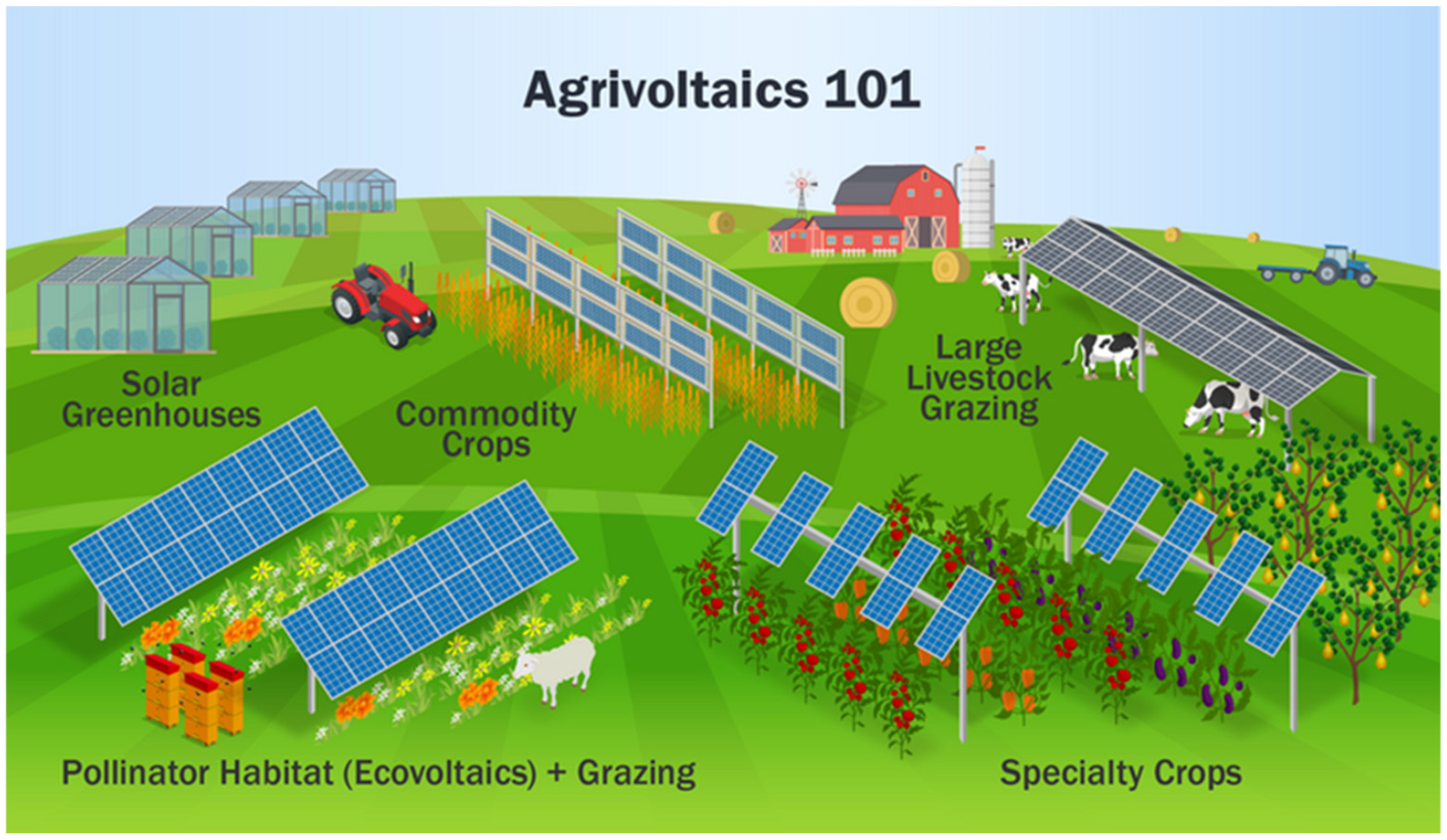
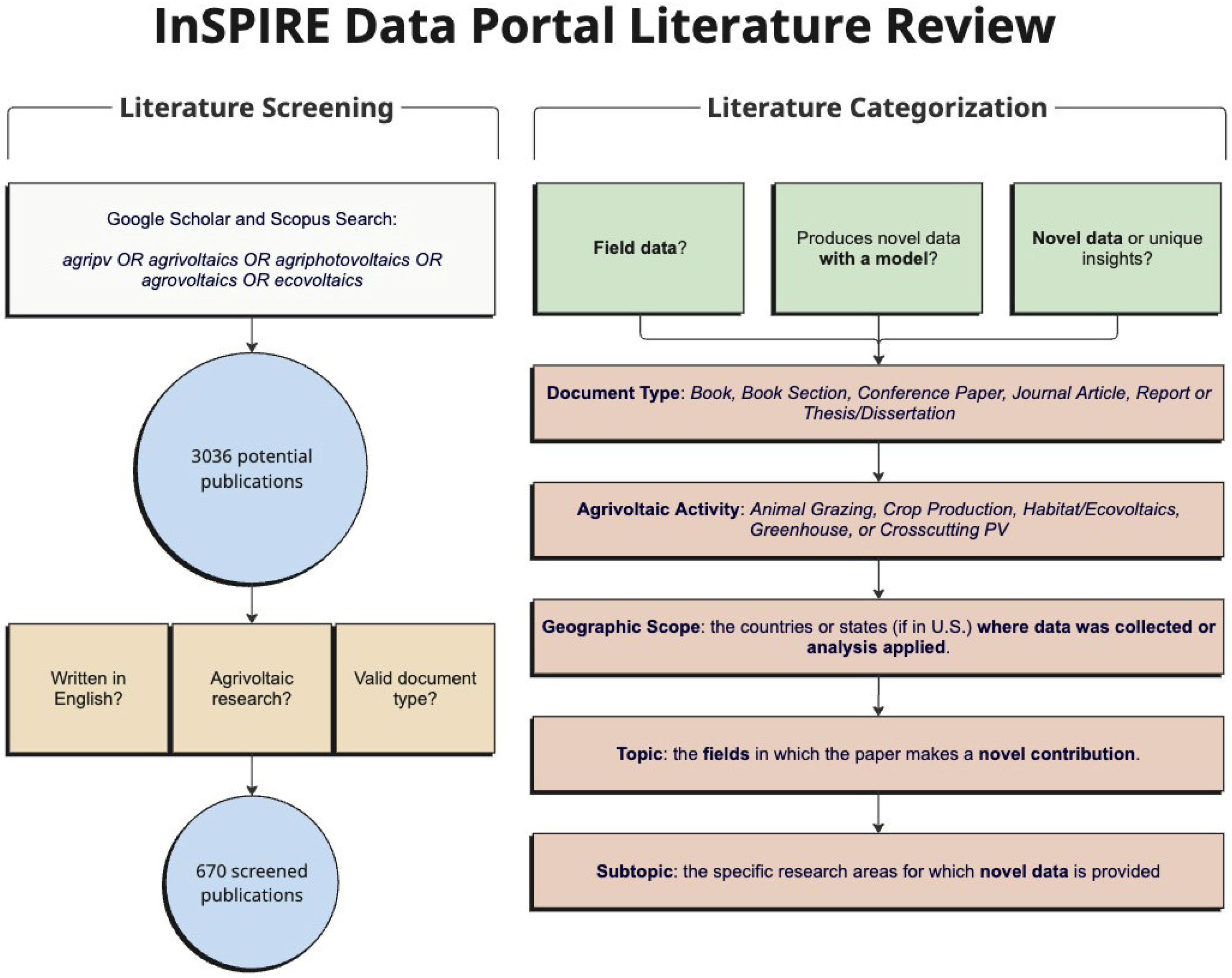
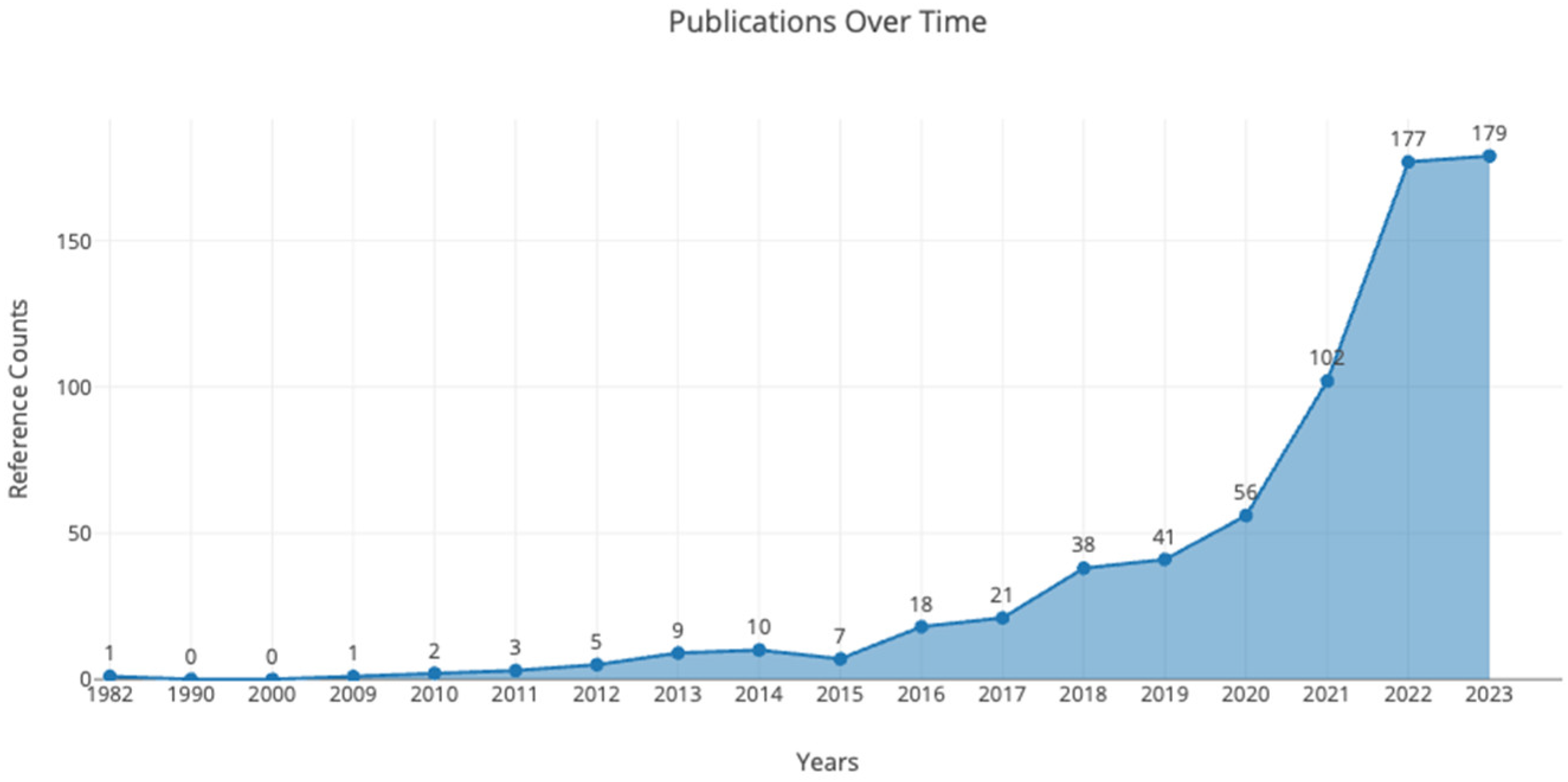


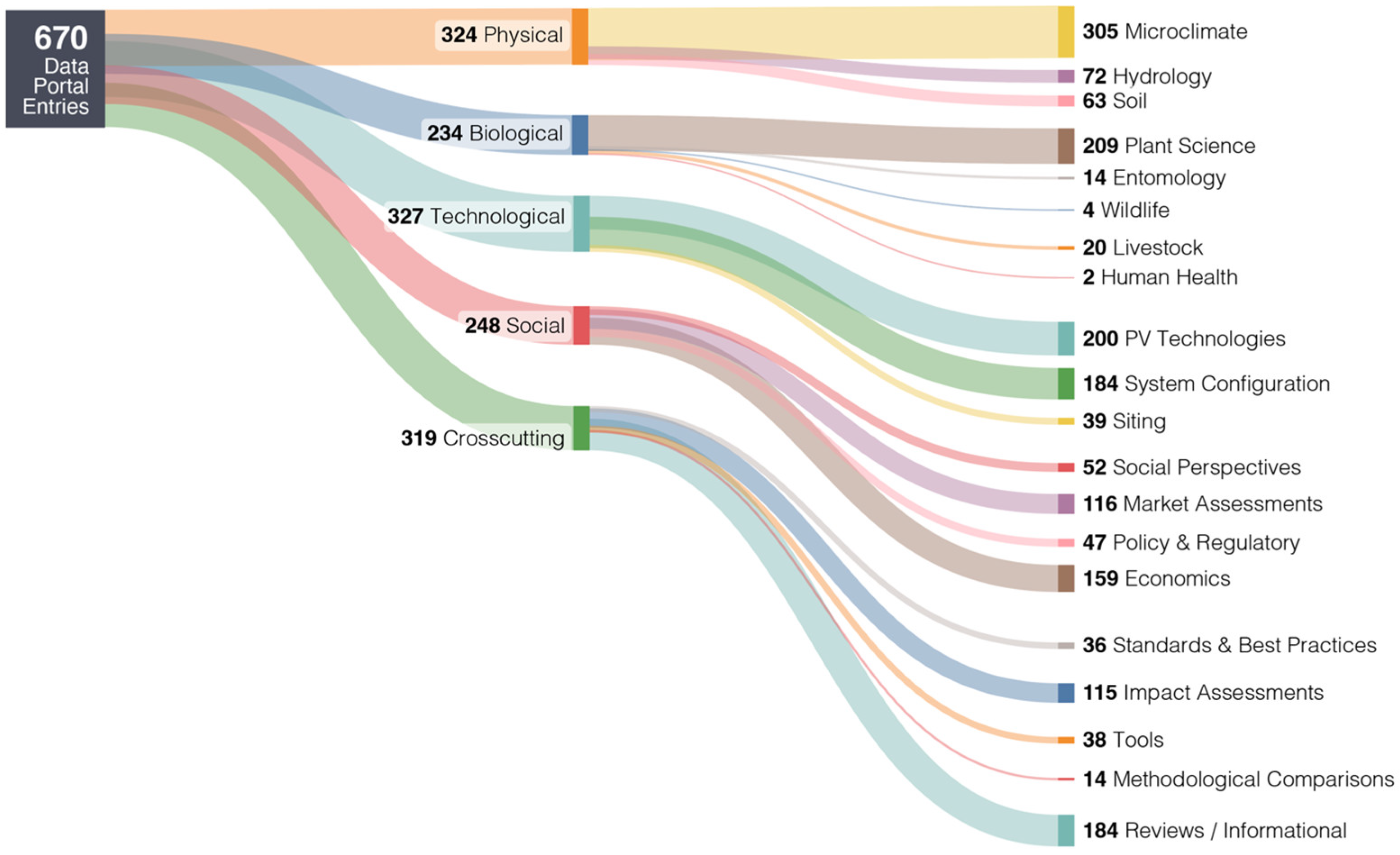
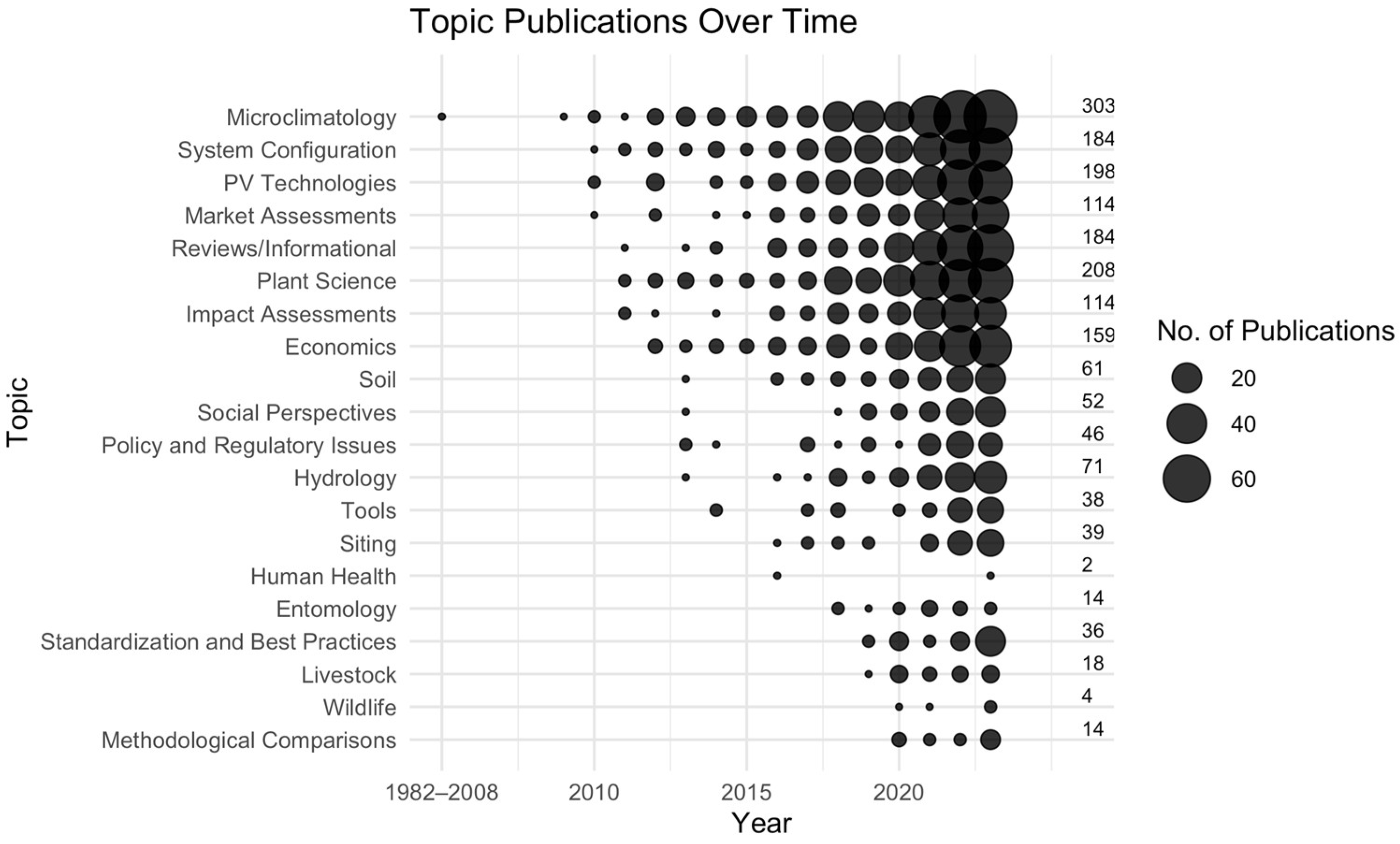
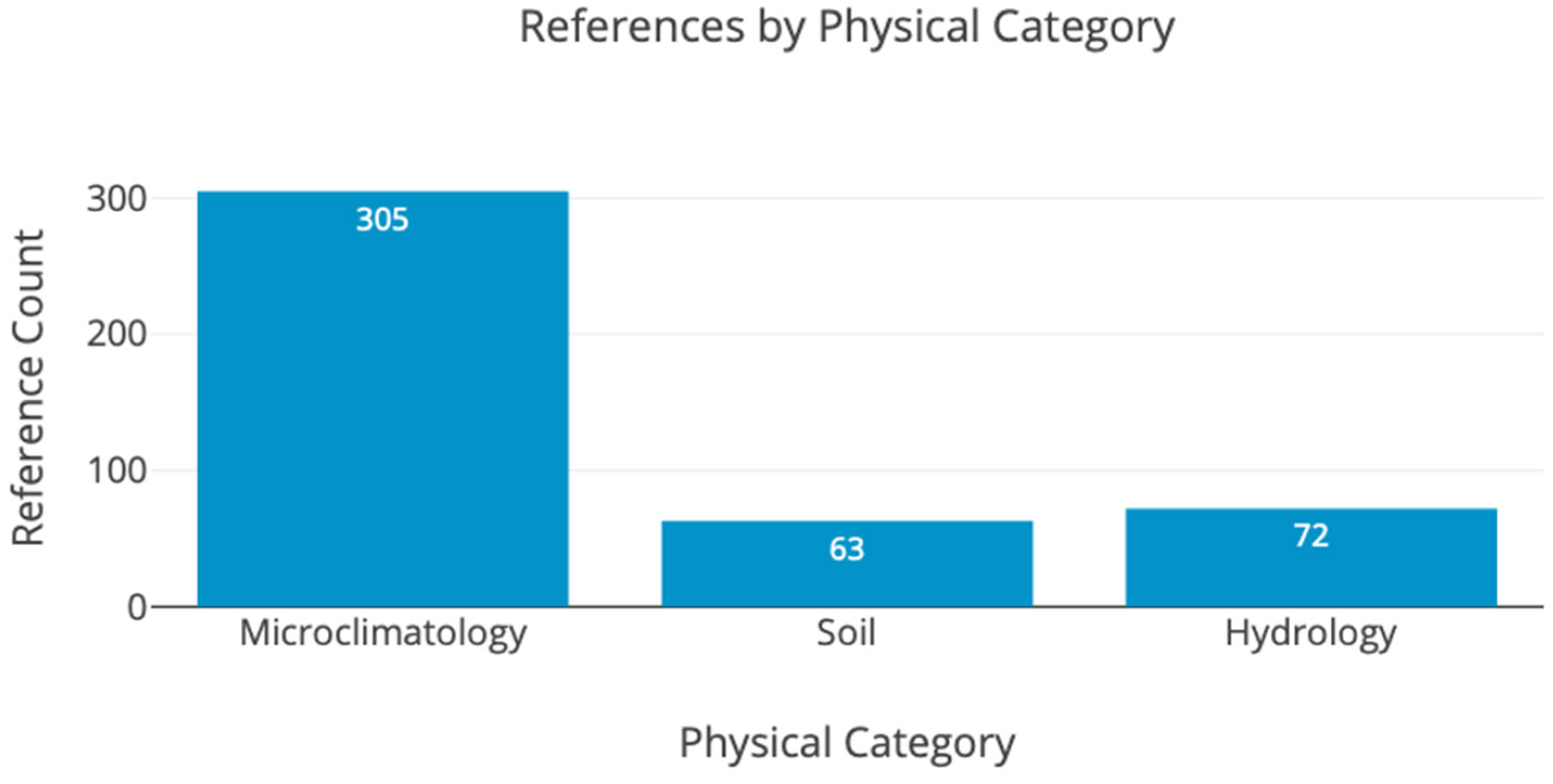

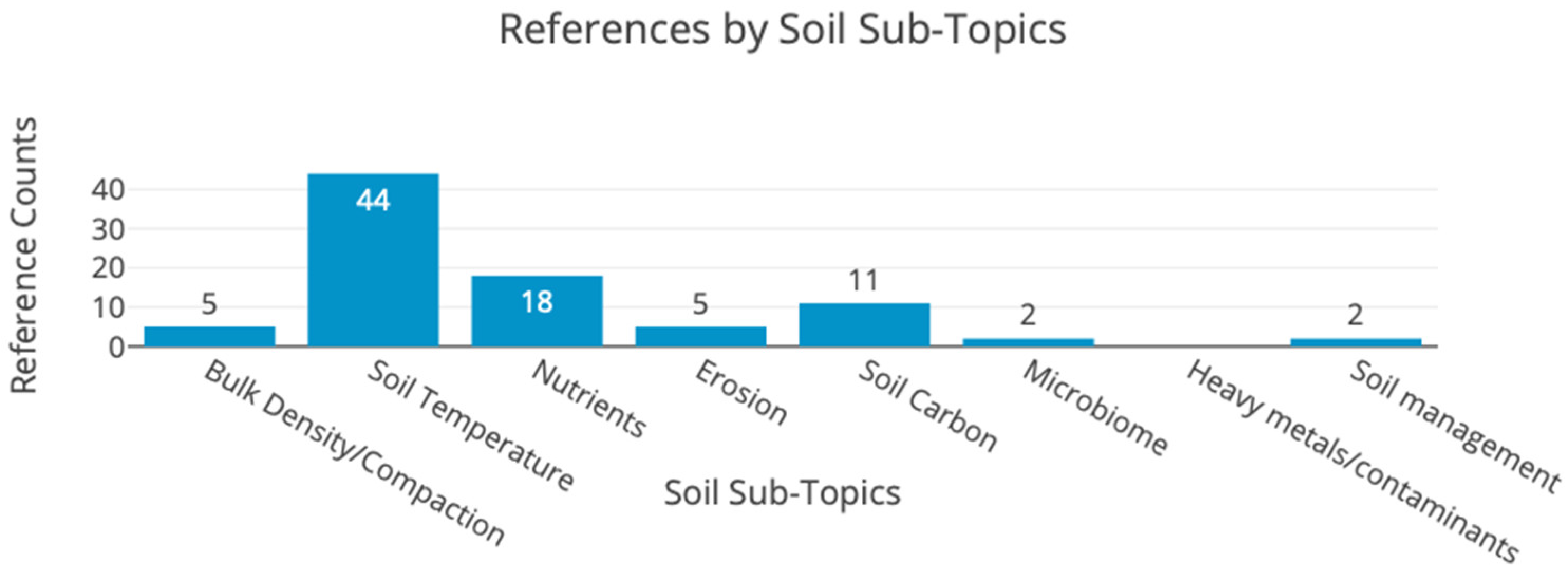
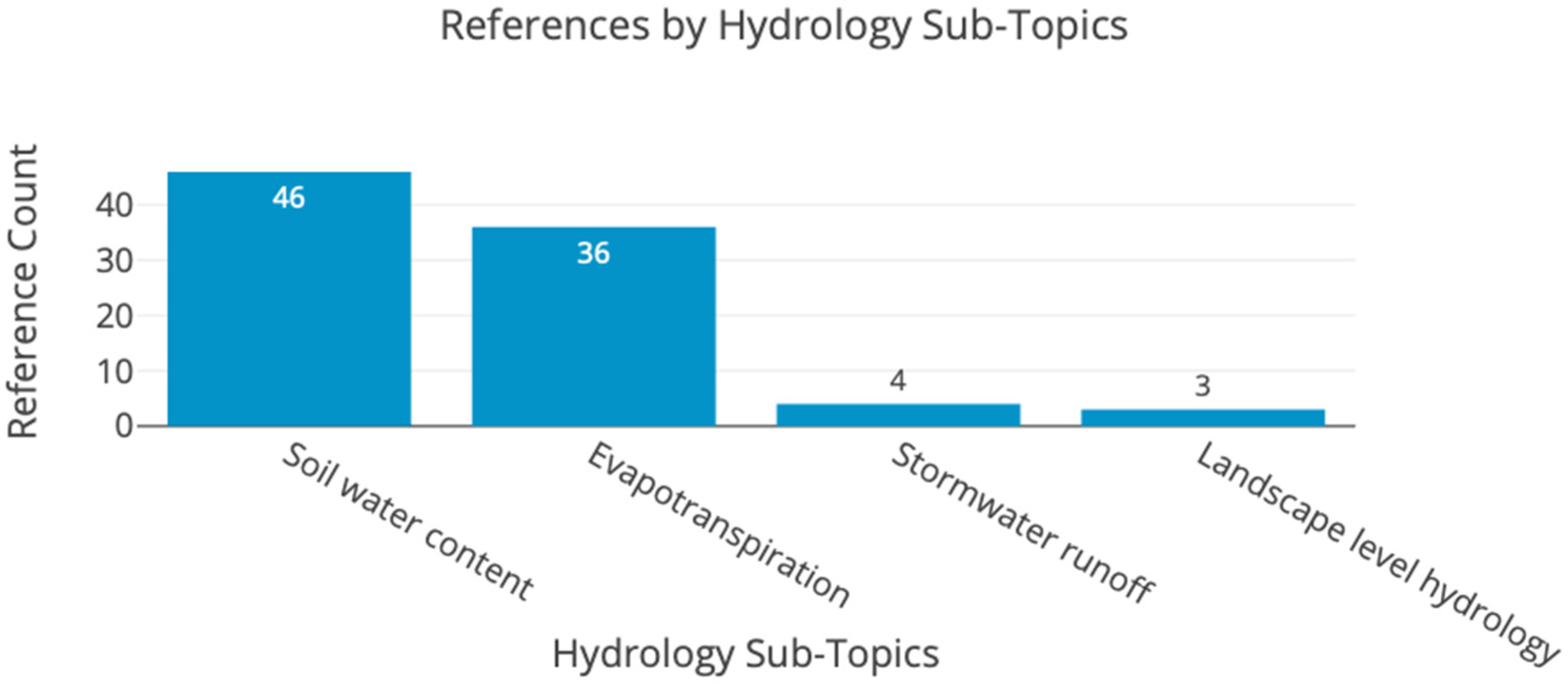
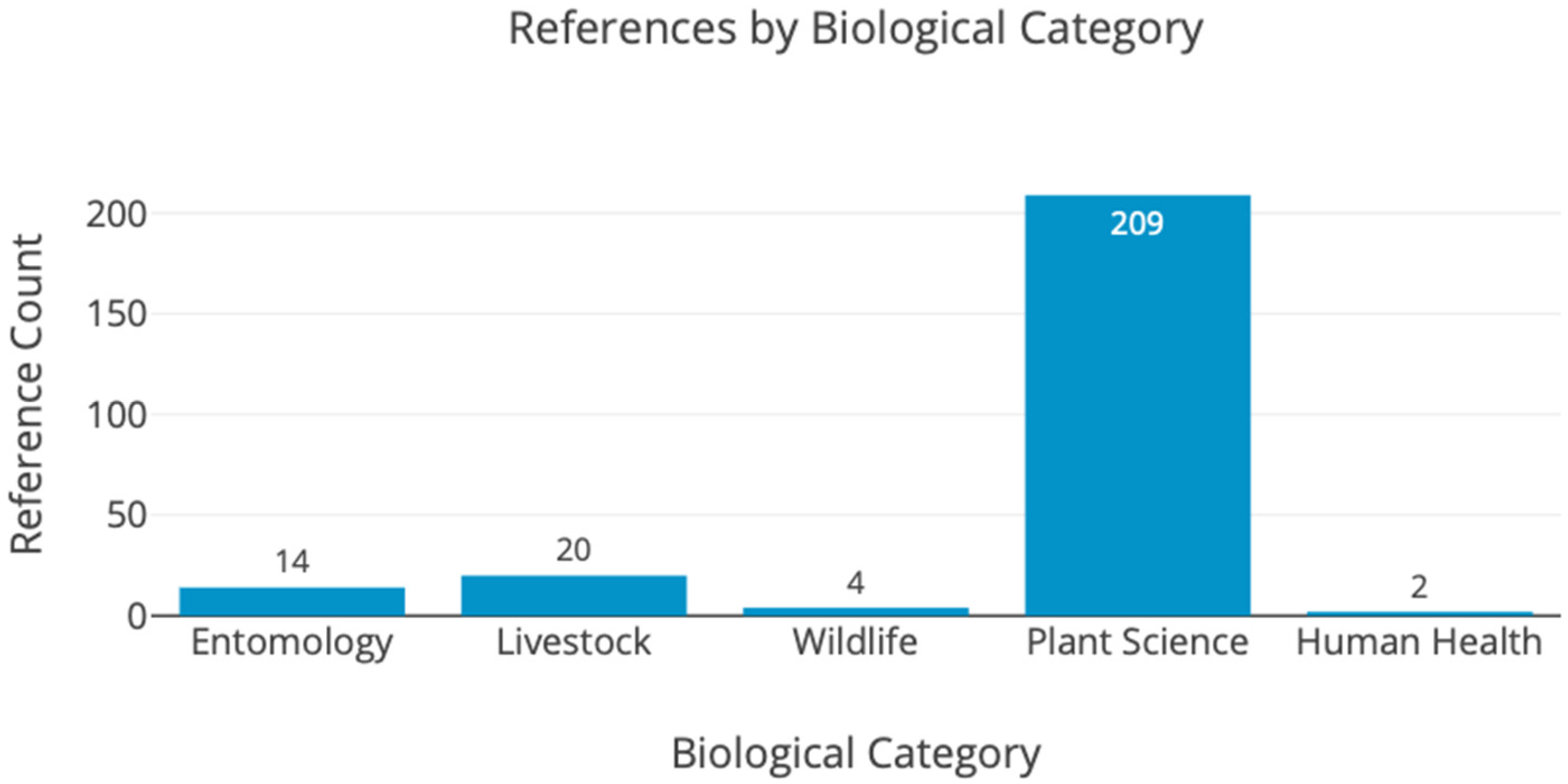
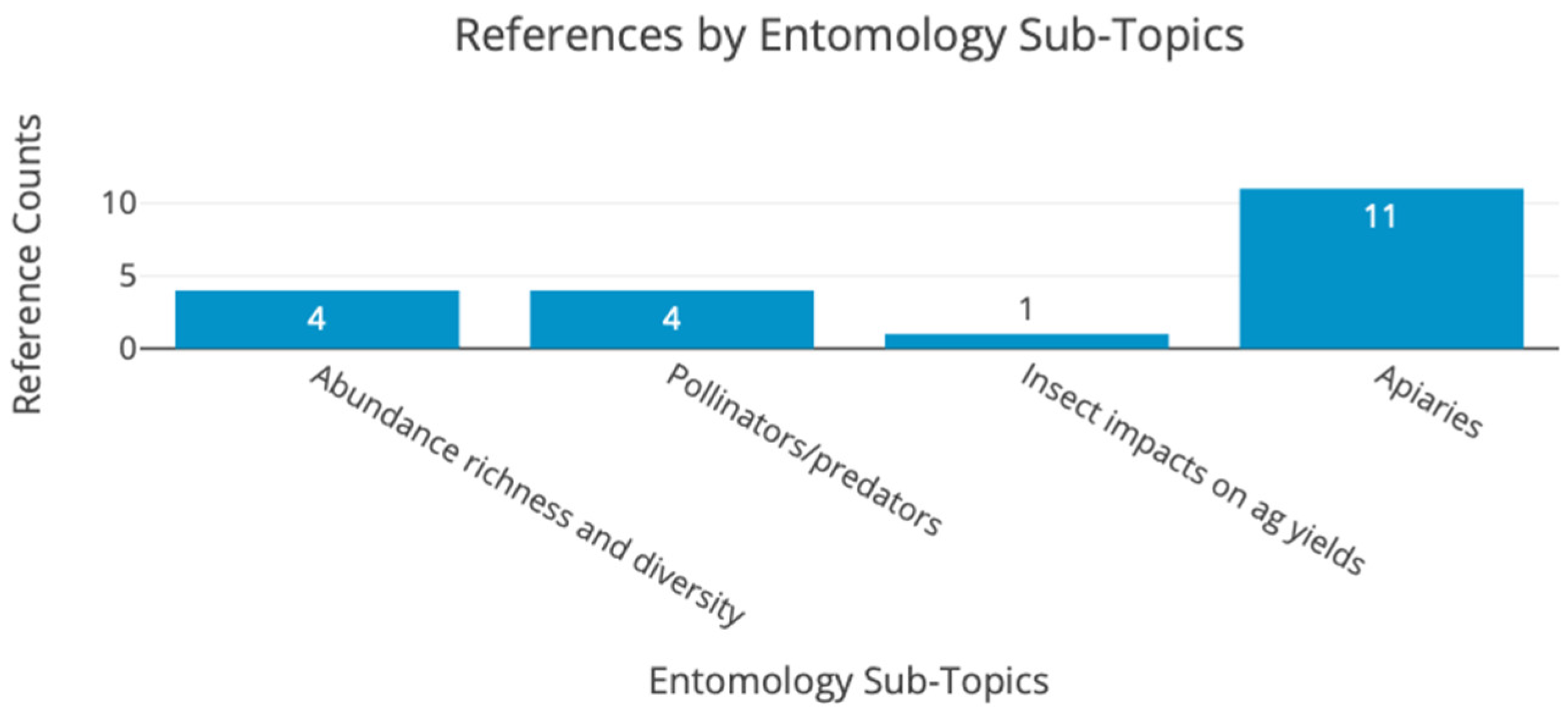
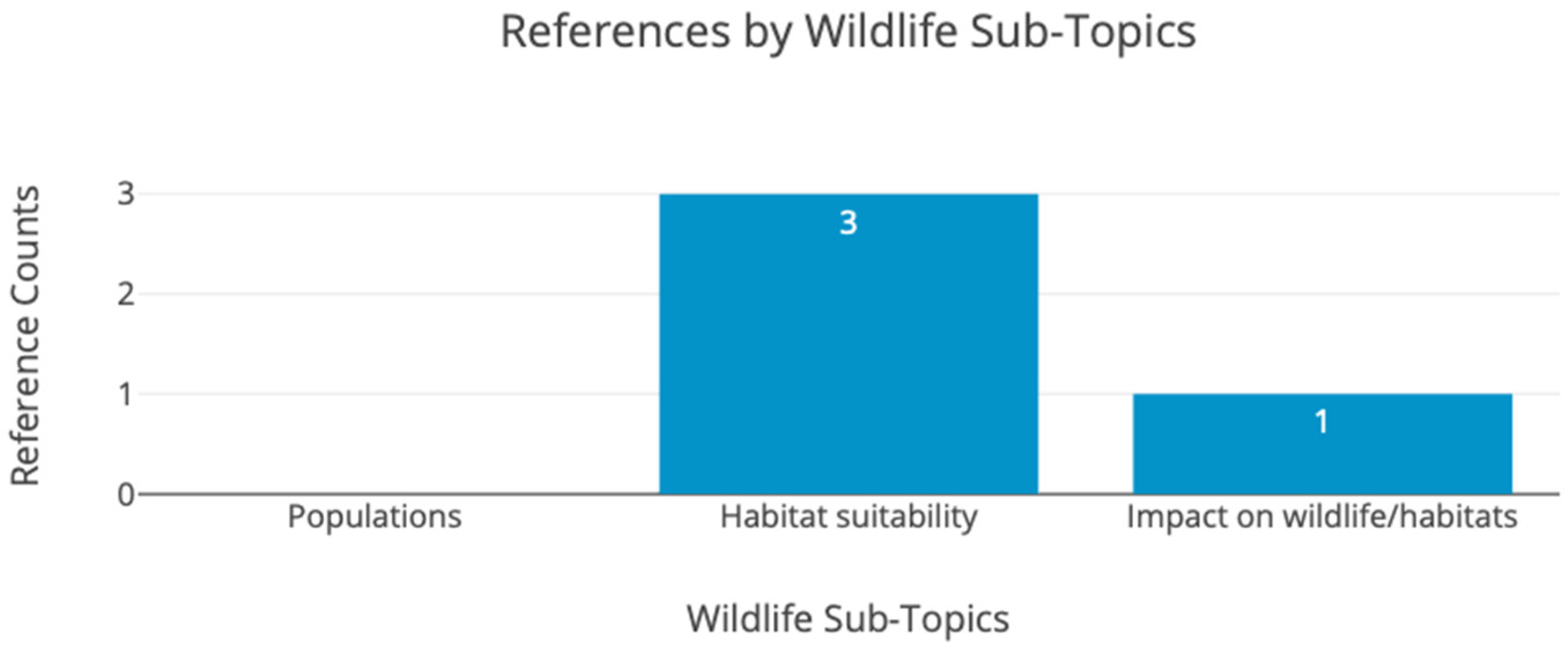
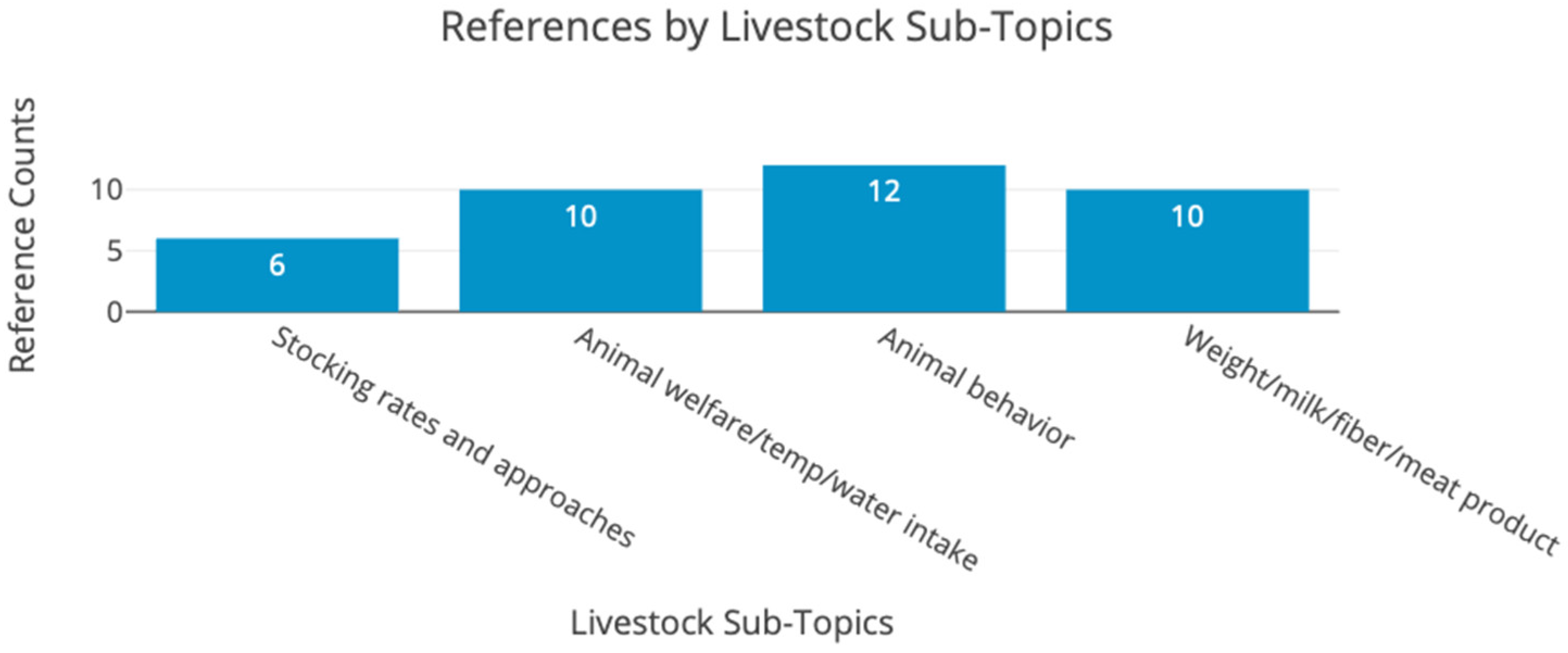
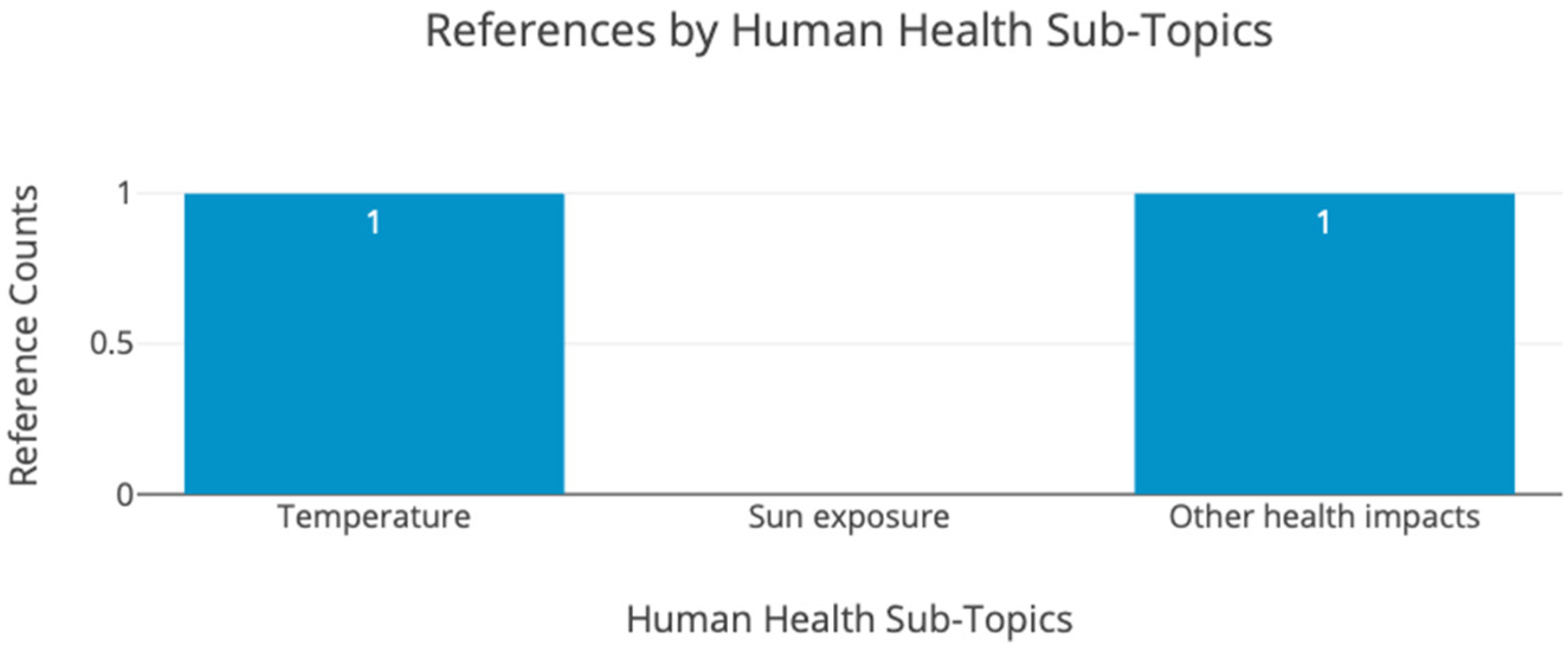
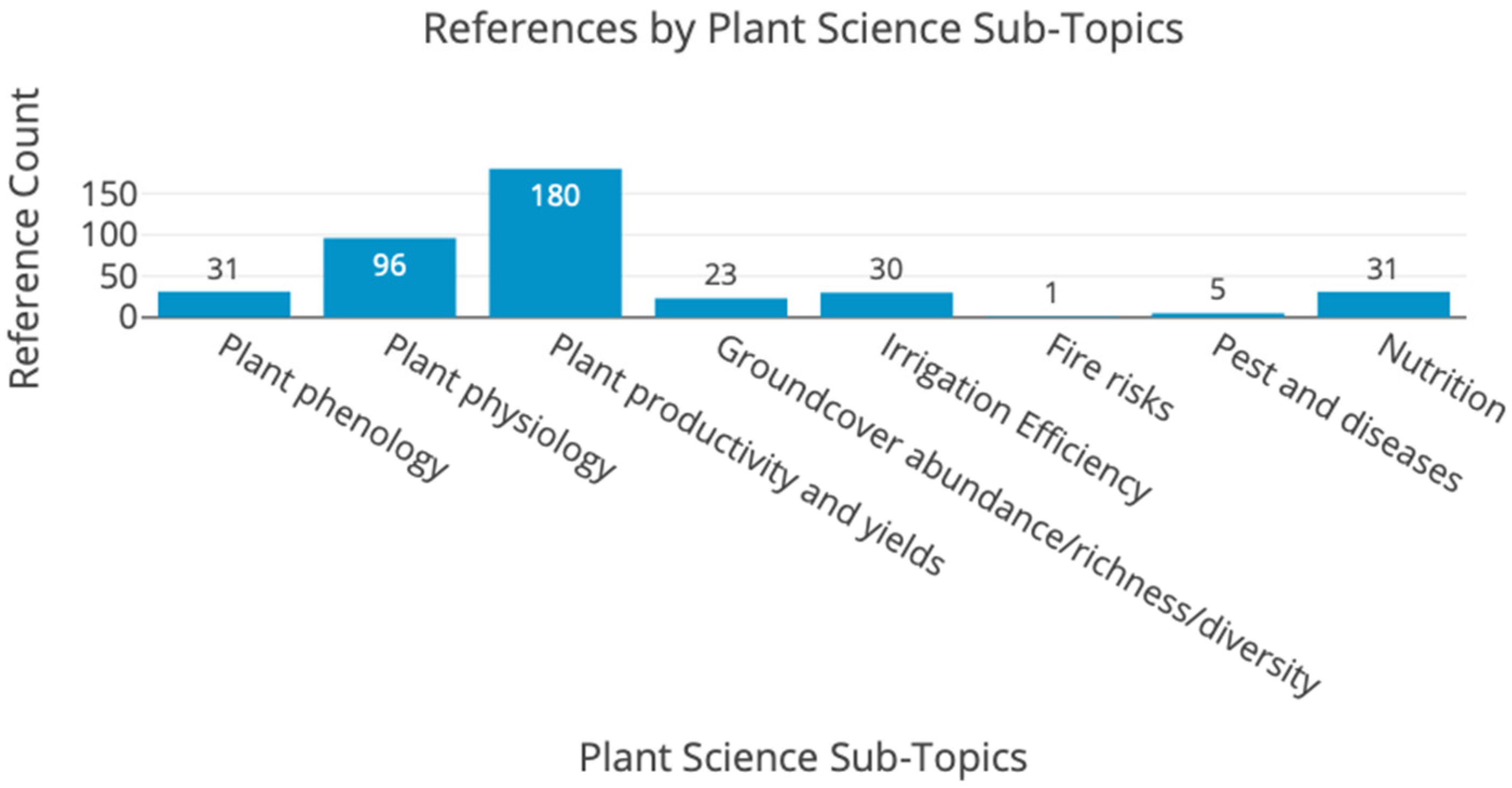
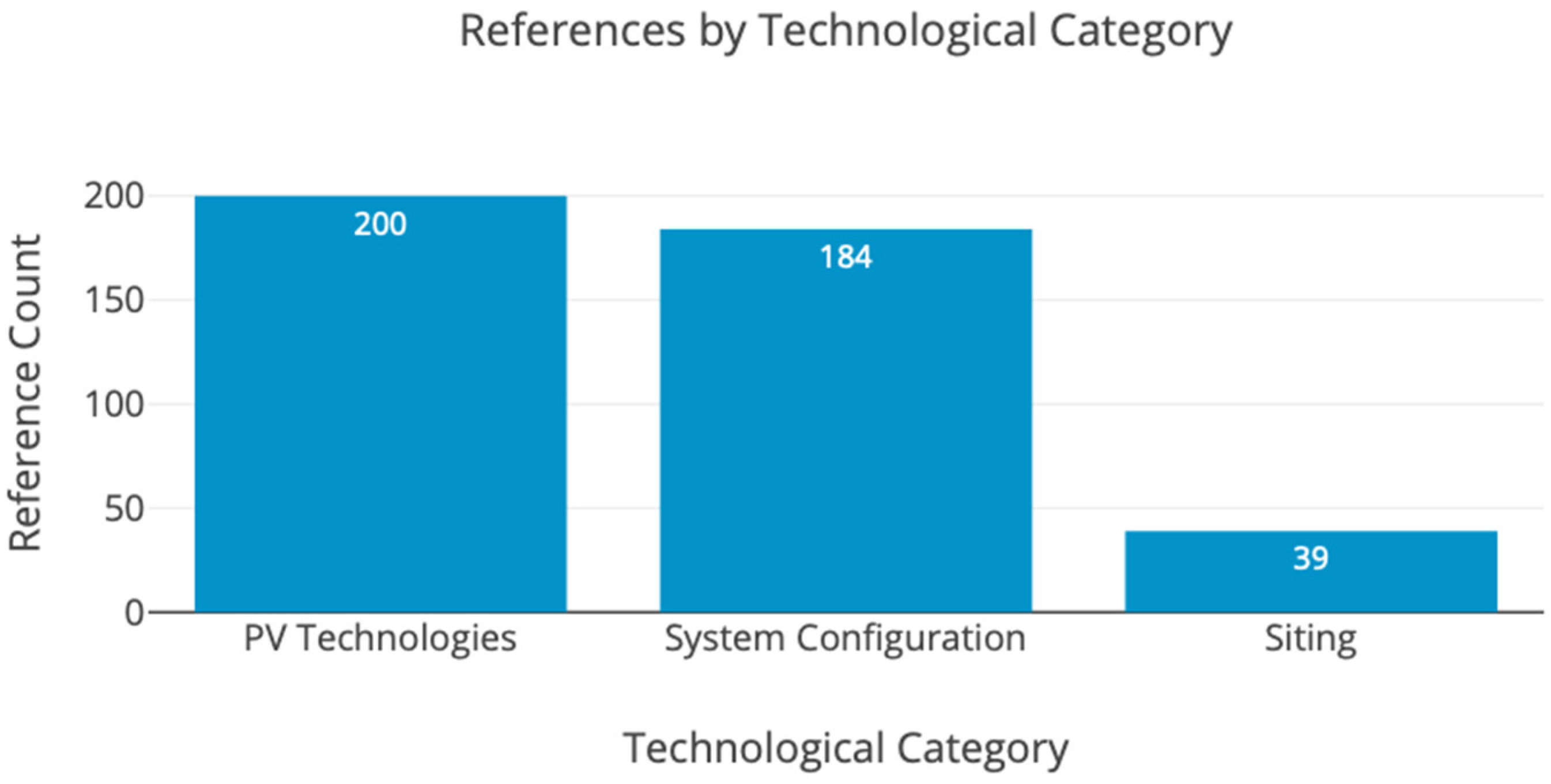
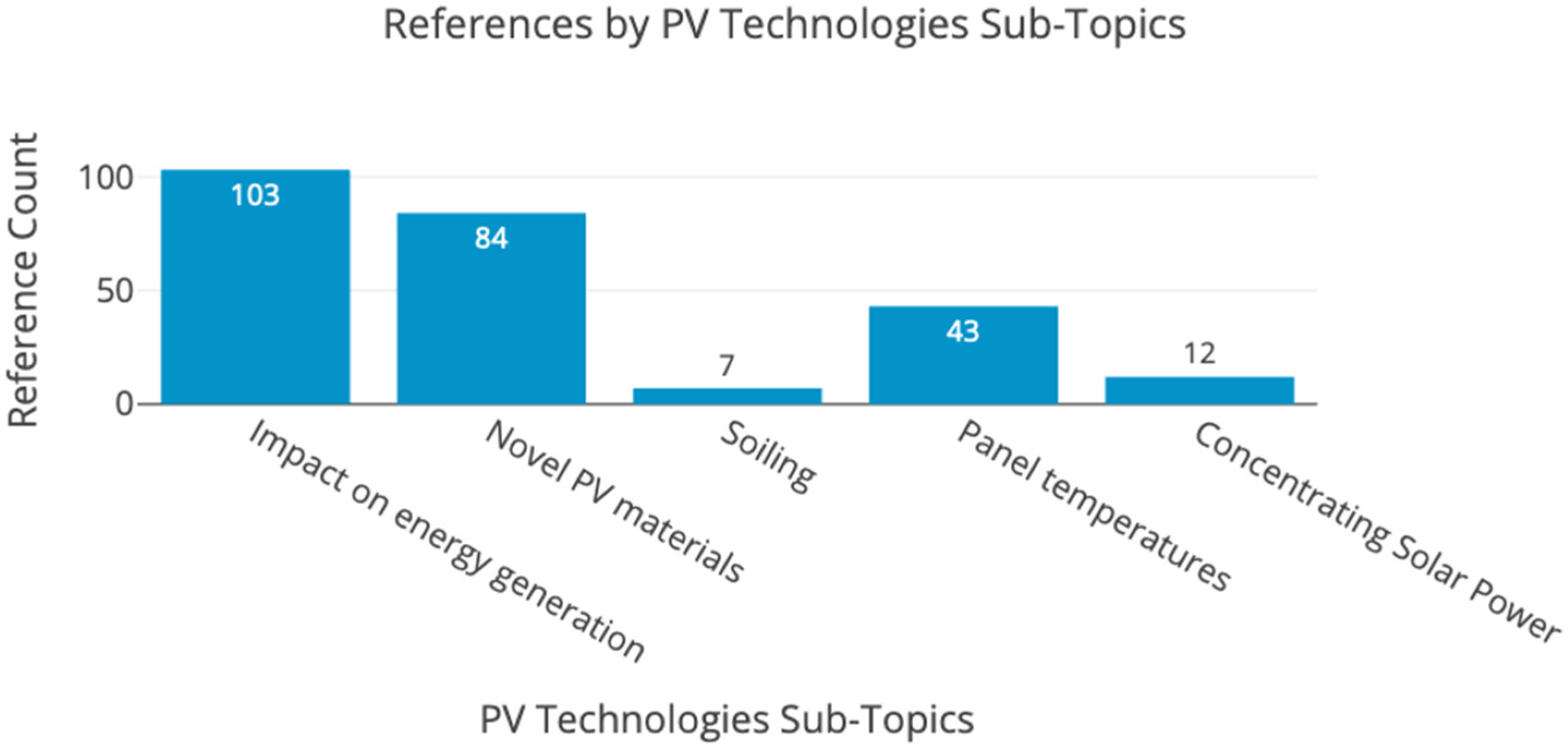
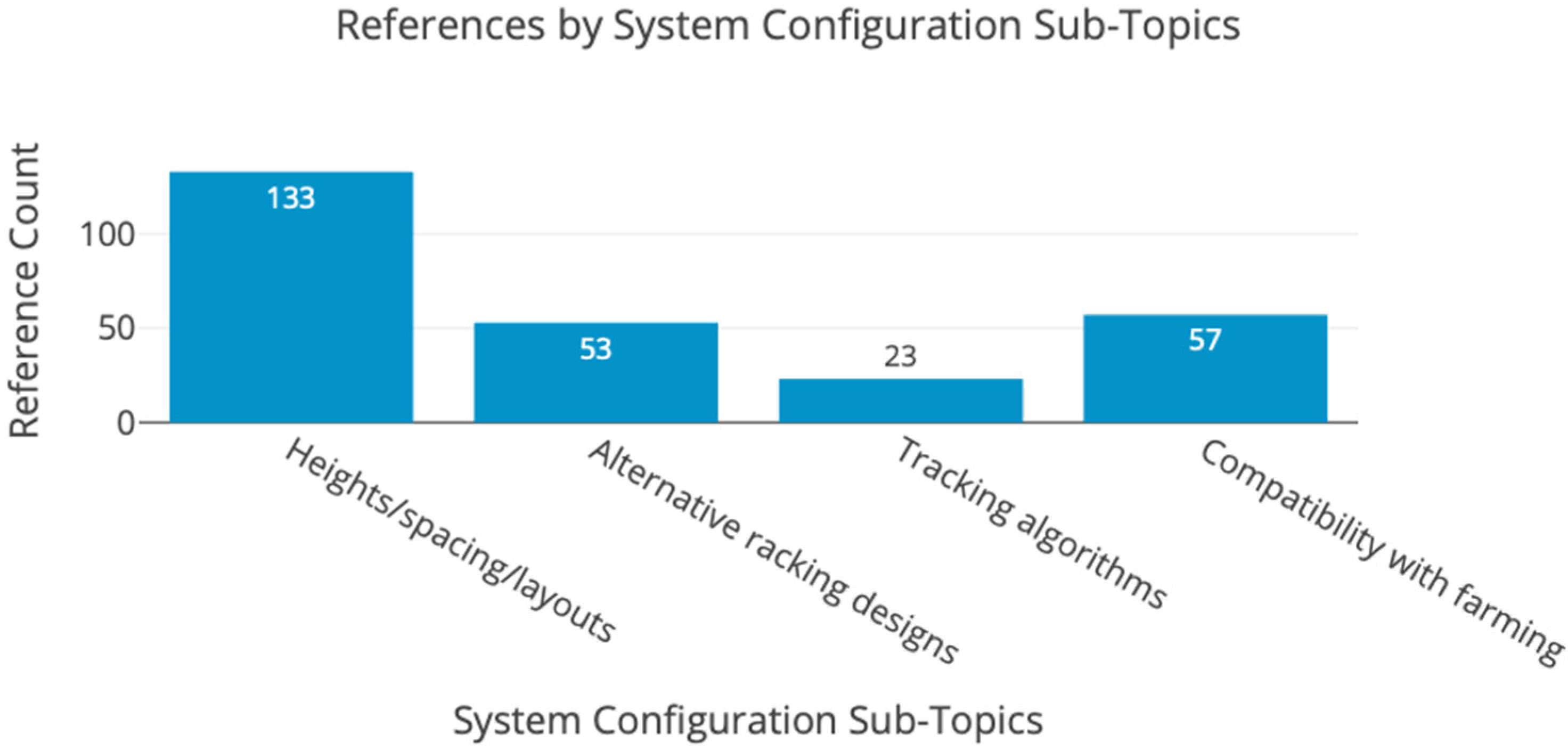


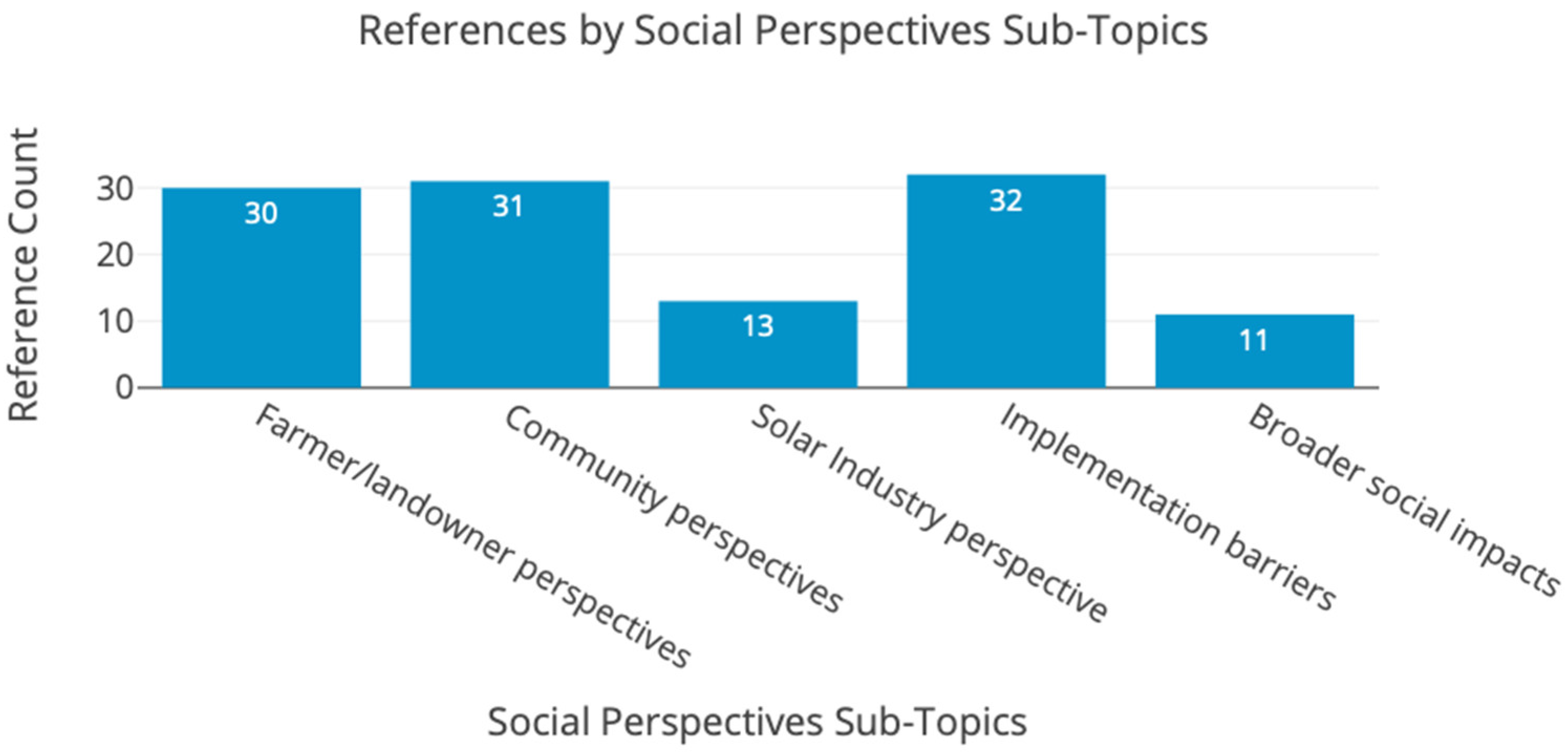
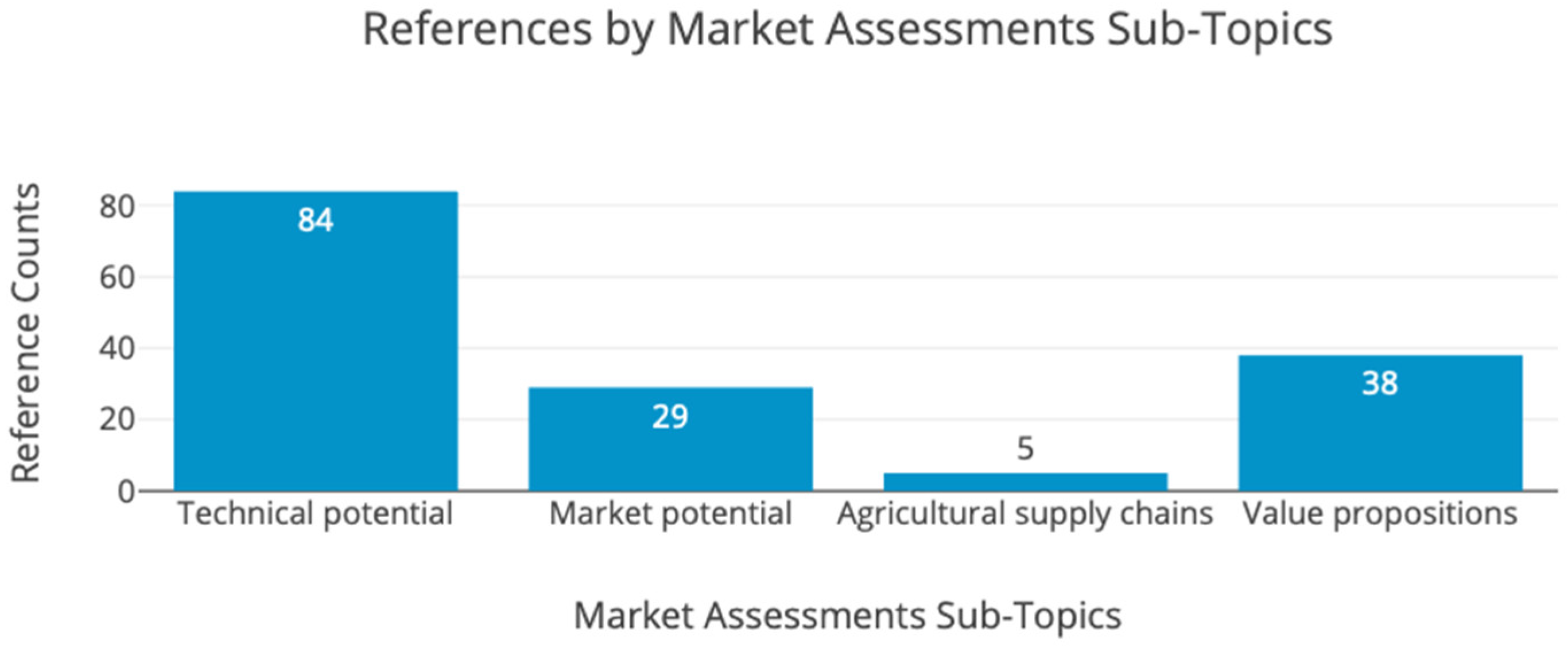
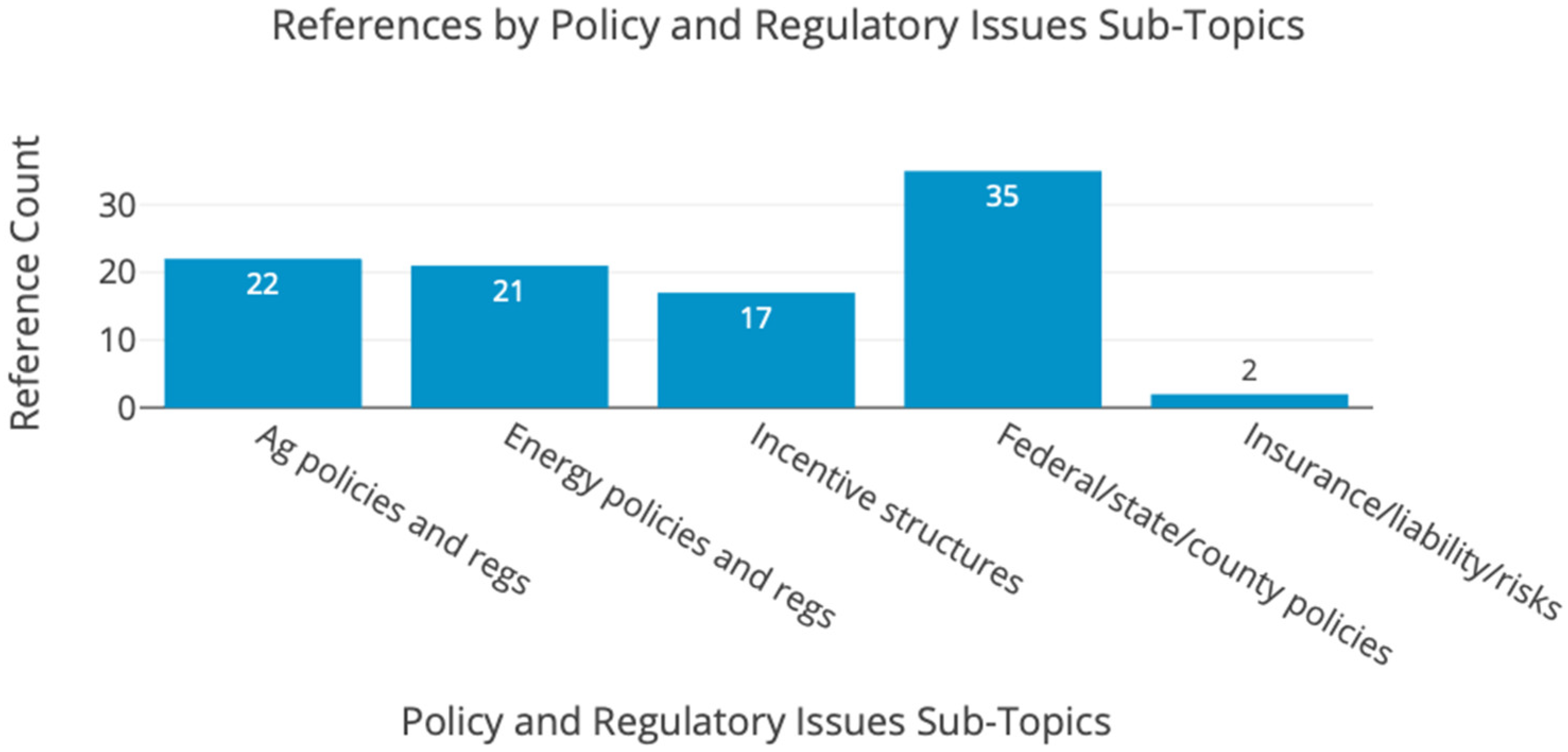

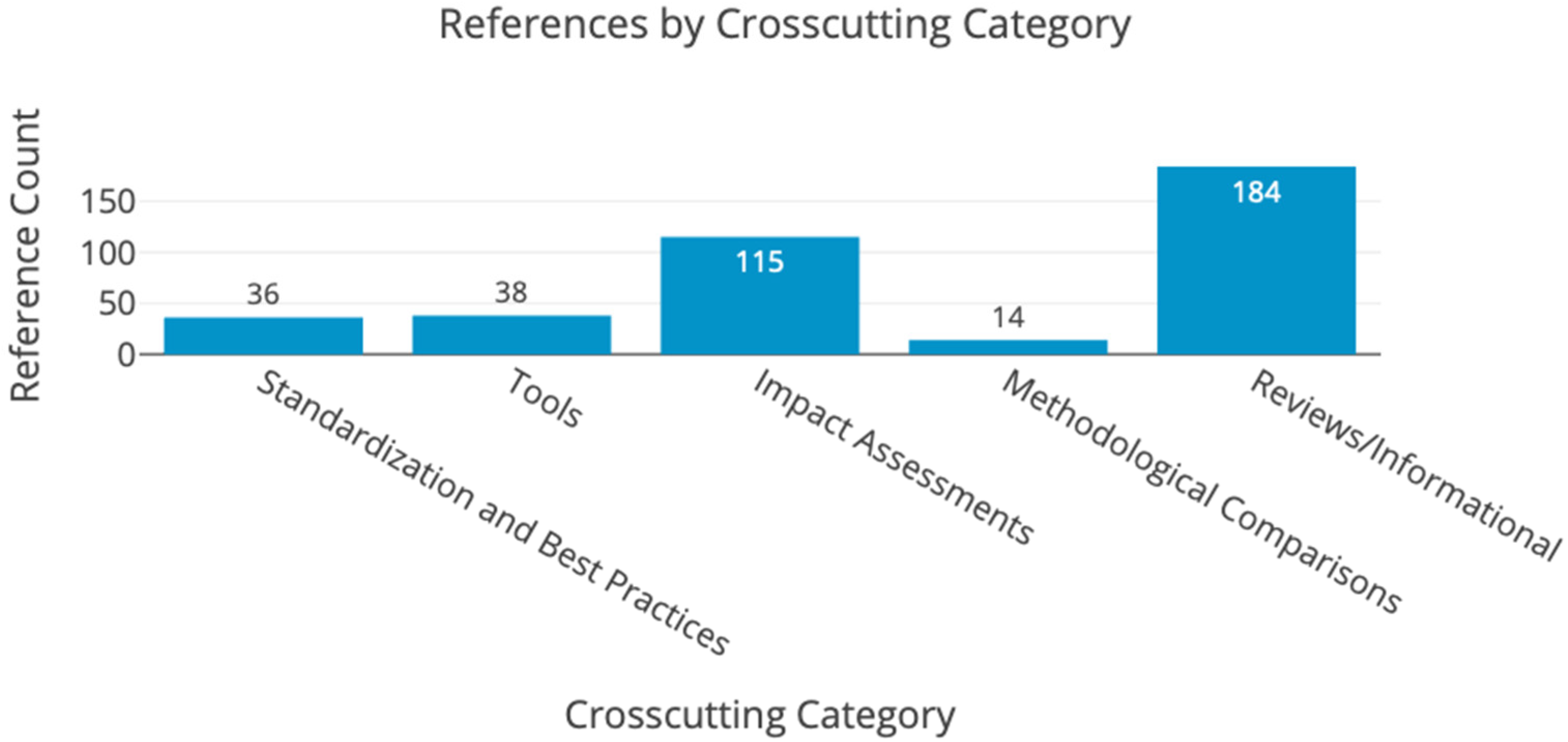
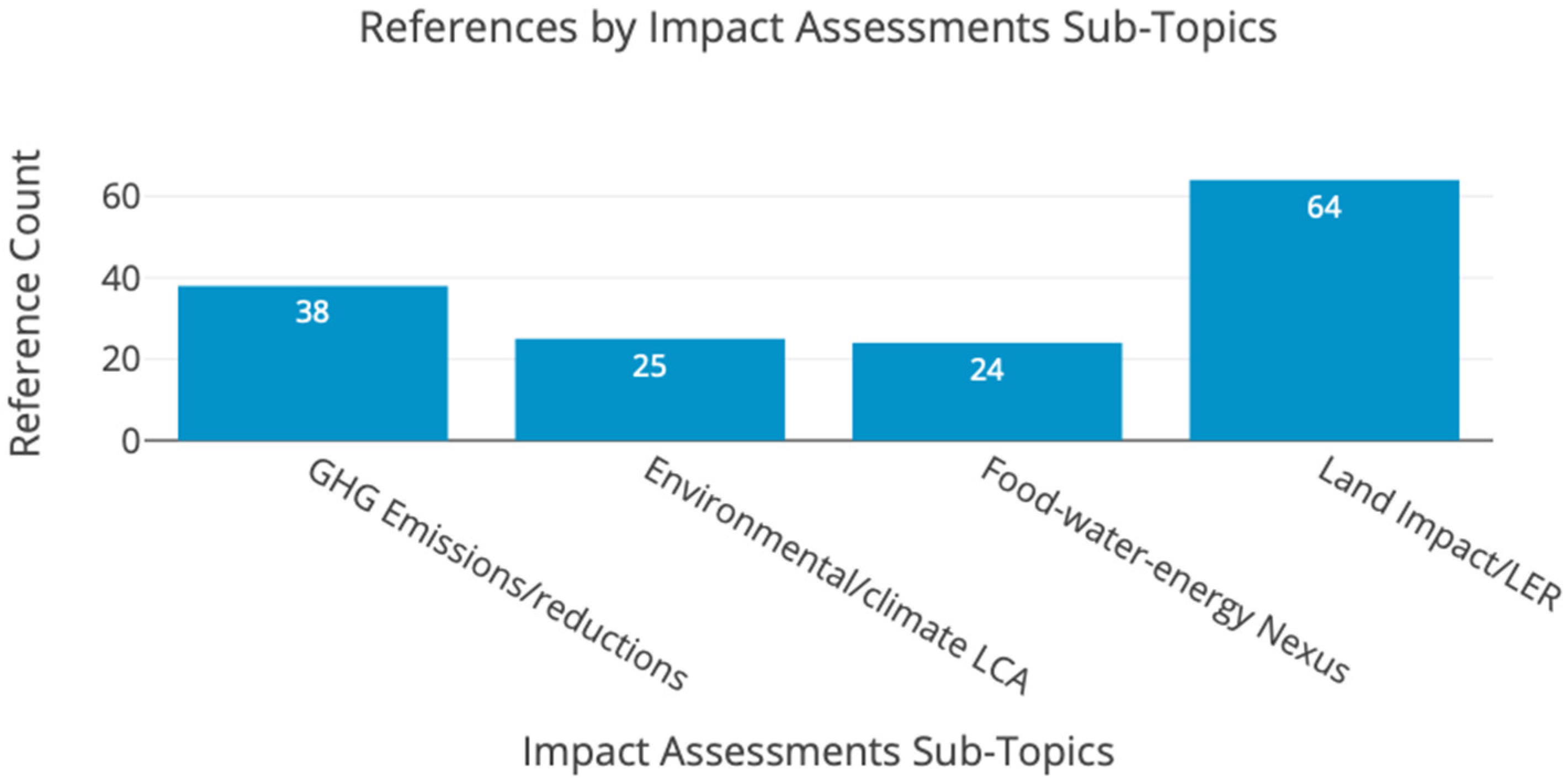
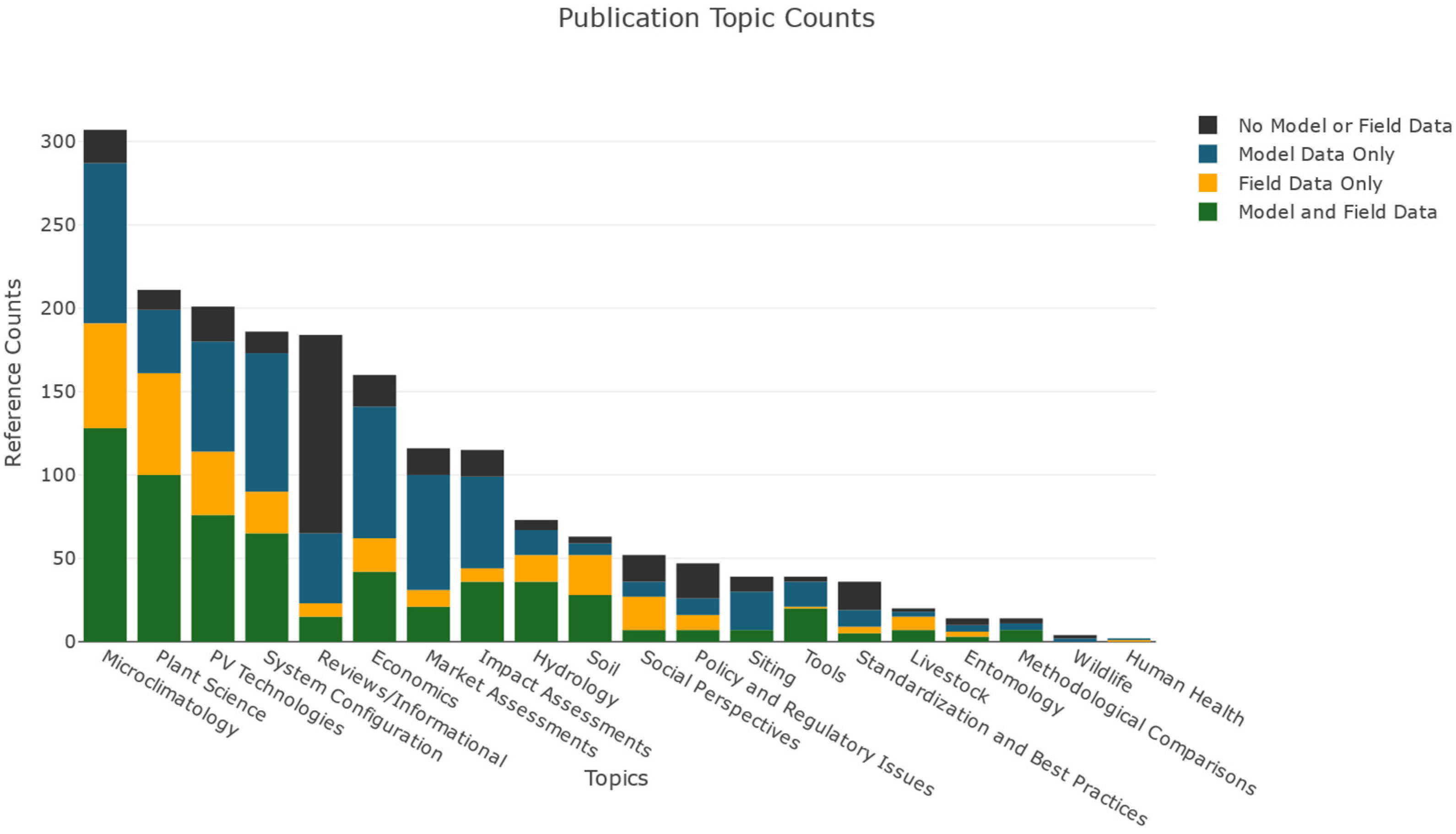
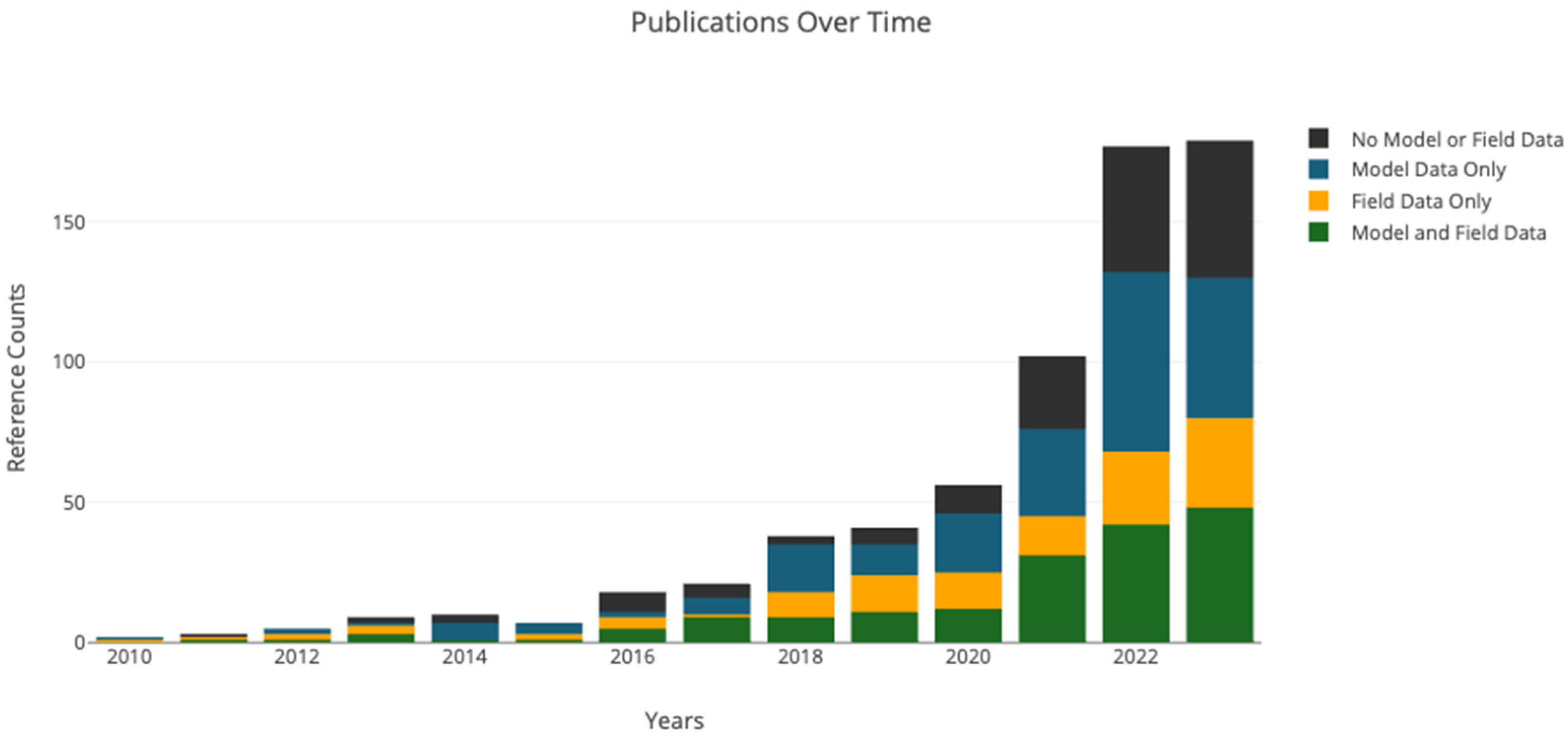
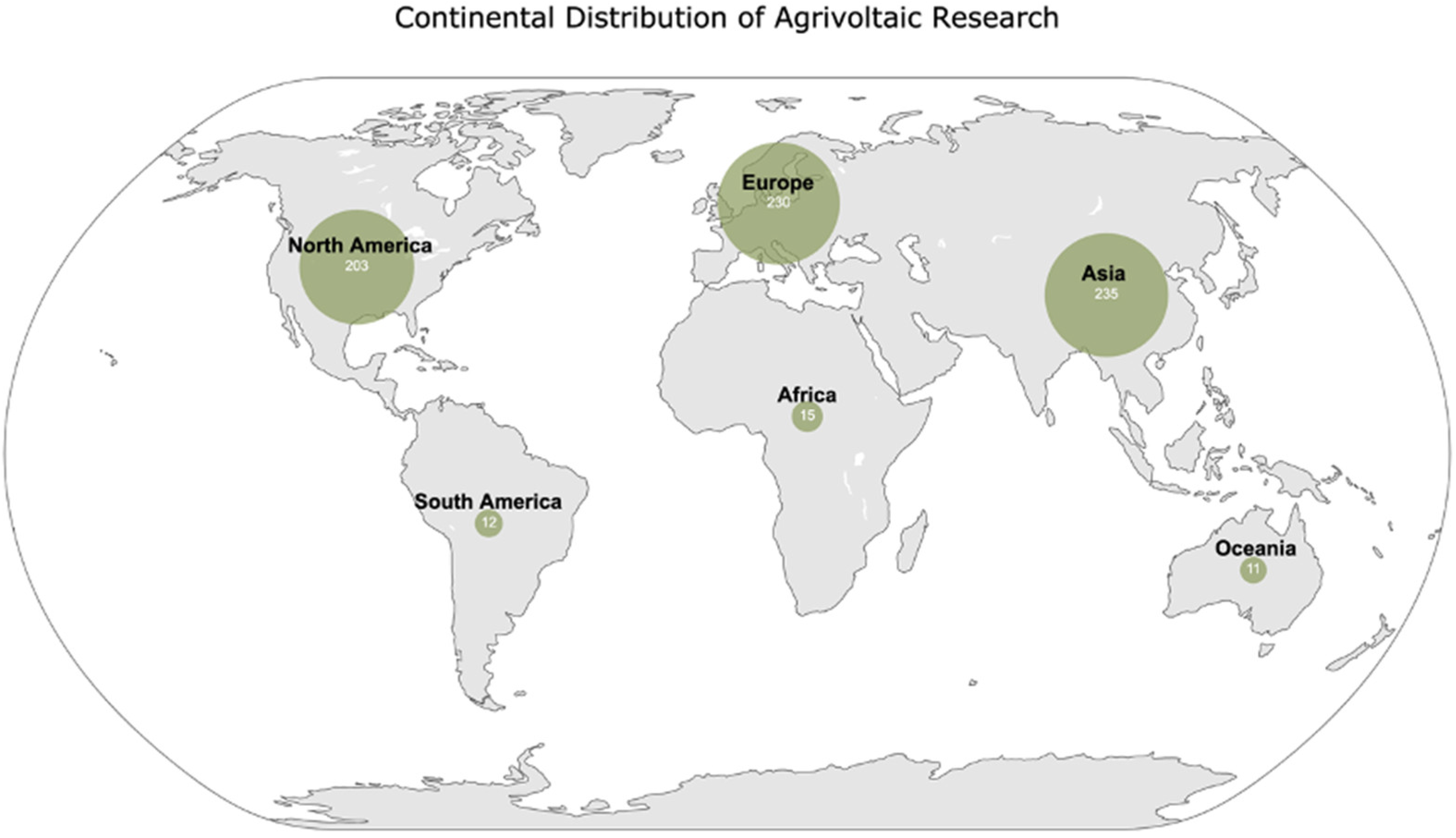
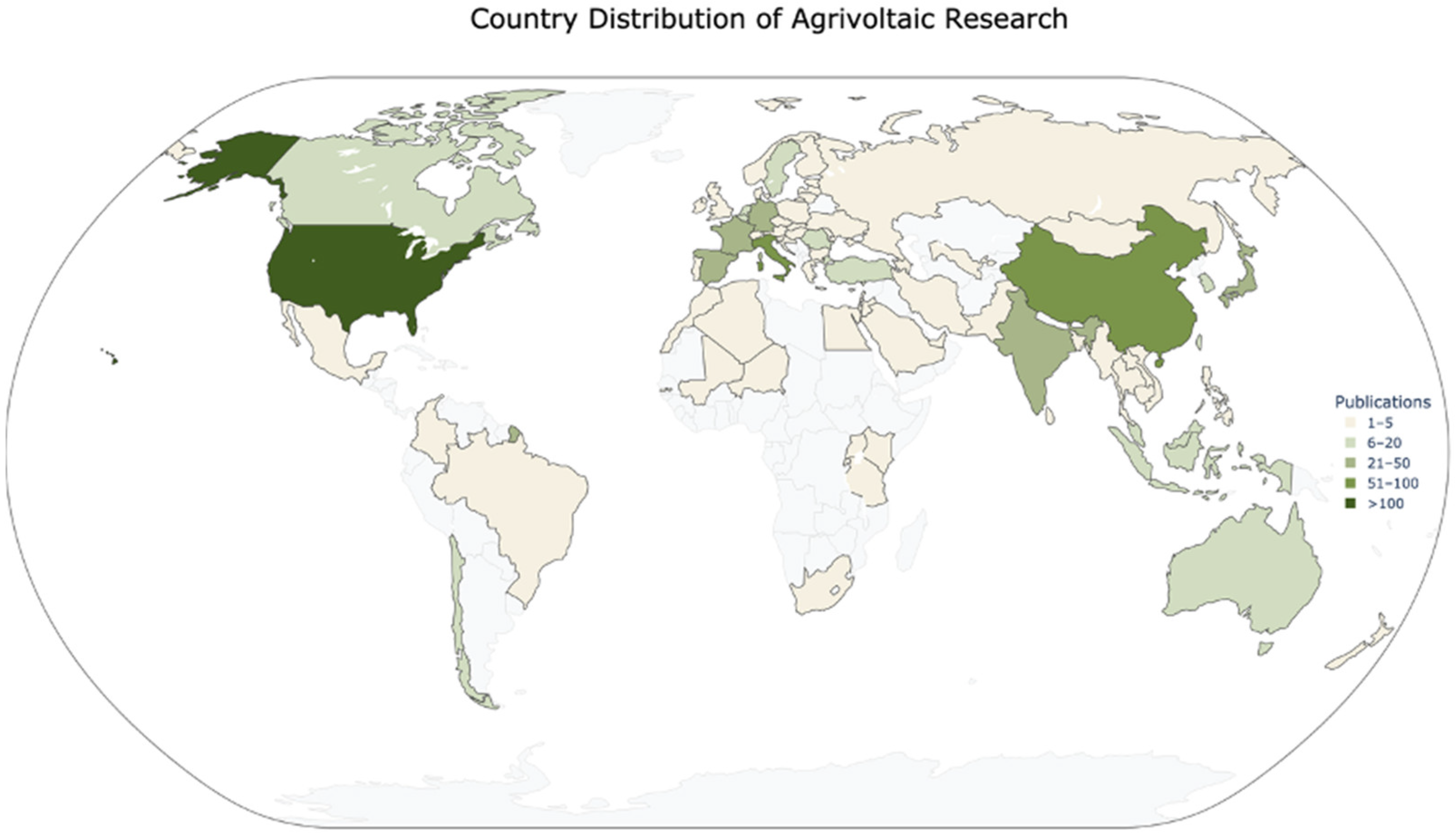

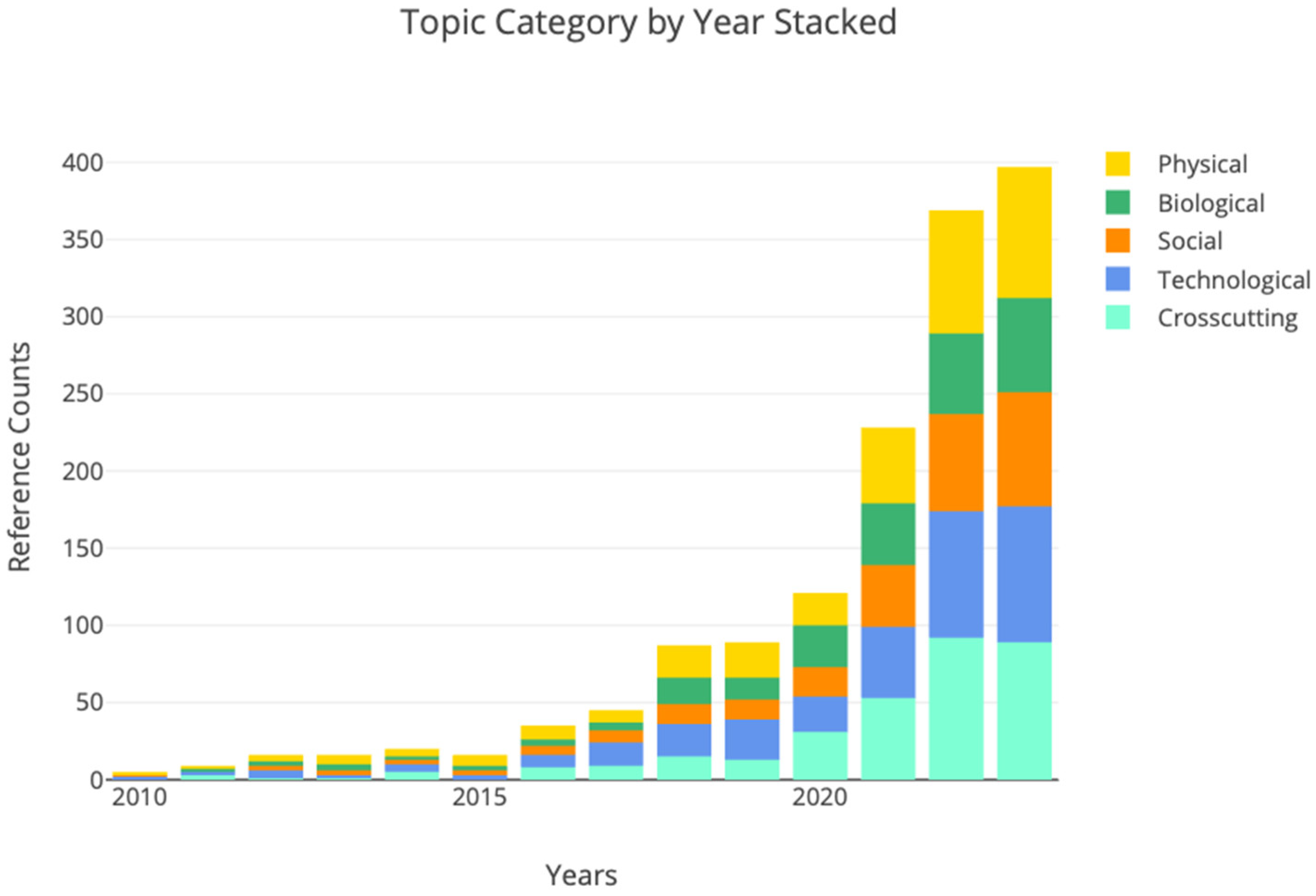

| Microclimatology Sub-Topic | Sub-Topic Definition |
|---|---|
| Air Temperature | Air temperature in agrivoltaic systems, generally to compare to standard agricultural or PV systems |
| Relative Humidity | Relative humidity in agrivoltaic systems, generally to compare to standard agricultural or PV systems |
| Wind and Airflow | Wind direction, speed, turbulence, pressure, and other relevant aspects of wind in relation to agrivoltaic systems |
| Light and Shading | Patterns of light and shade within agrivoltaic systems generally related to the shade introduced by PV modules and racking |
| PAR/PPFD | Photosynthetically active radiation (PAR) and photosynthetic photon flux density (PPFD) within agrivoltaic systems. Studies within this sub-topic are necessarily also in the Light and Shading sub-topic, but not all Light and Shading studies must be within the PAR/PPDF sub-topic |
| Soil Sub-Topic | Sub-Topic Definition |
|---|---|
| Bulk Density/Compaction | Soil bulk density and other measures of soil compaction in agrivoltaic systems |
| Soil Temperature | Soil temperature in agrivoltaic systems |
| Nutrients | Soil nutrients in agrivoltaic systems including macronutrients (nitrogen, phosphorus, potassium, calcium, magnesium, and sulfur), micronutrients (iron, manganese, zinc, copper, boron, molybdenum, and chlorine), and related measures such as pH and cation exchange capacity |
| Erosion | Soil erosion in agrivoltaic systems |
| Soil Carbon | Soil carbon in agrivoltaic systems including soil organic carbon (SOC) and soil inorganic carbon (SIC) |
| Microbiome | Soil microbiome in agrivoltaic systems including the diversity and abundance of bacteria, fungi, archaea, and other microorganisms and the processes they contribute to in soil function |
| Heavy Metals/Contaminants | The presence and impact of heavy metals and other soil contaminants in agrivoltaic systems |
| Soil Management | Soil management practices in agrivoltaic systems including but not limited to cover cropping, crop rotation, tilling practices, grading, excavation, runoff control, and soil treatments |
| Hydrology Sub-Topic | Sub-Topic Definition |
|---|---|
| Soil Water Content | Soil water content or other measures of soil moisture in agrivoltaic systems |
| Evapotranspiration | Evapotranspiration—the combined processes of evaporation of water from soil or other materials and transpiration of water through plants—in agrivoltaic systems |
| Stormwater Runoff | Stormwater runoff—the portion of rain or snow that flows over the land surface—in agrivoltaic systems |
| Landscape-Level Hydrology | Broad patterns of water movement in relation to agrivoltaic systems |
| Entomology Sub-Topic | Sub-Topic Definition |
|---|---|
| Abundance, Richness, and Diversity | Insect population metrics—including size, species distribution, and diversity—and their interactions with the agrivoltaic environment |
| Pollinators/Predators | The roles of insects and arthropods as pollinators or predators, evaluating their contributions to ecosystem services and crop productivity in agrivoltaic systems |
| Insect Impacts on Agricultural Yields | The beneficial and detrimental effects of insects on crop yields, focusing on how pollinator and pest dynamics vary in agrivoltaic systems |
| Apiaries | The colocation of beehives within PV arrays or beekeeping in agrivoltaic systems |
| Wildlife Sub-Topic | Sub-Topic Definition |
|---|---|
| Populations | Wildlife species and their population sizes in agrivoltaic systems |
| Habitat Suitability | Ways that agrivoltaic systems modify wildlife habitat and influence wildlife distribution and habitat quality |
| Impact on Wildlife/Habitats | The long-term impacts of agrivoltaic systems on wildlife behavior and habitat trends |
| Livestock Sub-Topic | Sub-Topic Definition |
|---|---|
| Stocking Rates and Approaches | Management strategies for livestock in agrivoltaic systems, focusing on optimal stocking rates and operational practices |
| Animal Welfare/Temperature/Water Intake | Measures of animal welfare in agrivoltaic systems including body temperature and water intake and their implications for livestock health |
| Animal Behavior | Livestock behavior in agrivoltaic systems including interactions with PV infrastructure and movement patterns |
| Weight, Milk, Fiber, Meat Production | Animal yield metrics such as weight gain, milk yield, fiber, and meat output in agrivoltaic systems |
| Human Health Sub-Topic | Sub-Topic Definition |
|---|---|
| Temperature | Environmental and body temperature variations in agrivoltaic systems specifically as they relate to human health |
| Sun Exposure | Human exposure to sun in agrivoltaic systems and related health outcomes |
| Other Health Impacts | Any other health impacts or outcomes related to humans working within or around agrivoltaic systems |
| Plant Science Sub-Topic | Sub-Topic Definition |
|---|---|
| Plant Phenology | The timing of plant developmental stages—such as germination, flowering, and senescence—in agrivoltaic systems |
| Plant Physiology | Plant physiology in agrivoltaic systems including plant physiological traits such as photosynthesis, water-use efficiency, and nutrient uptake |
| Plant Productivity and Yields | Metrics of crop productivity in agrivoltaic systems including crop yield and plant biomass |
| Groundcover Abundance/ Richness/Diversity | The abundance, richness, and diversity of plant species within agrivoltaic systems. This could include measures of agricultural or non-agricultural plants such as pollinator habitat beneath photovoltaics |
| Irrigation Efficiency | Irrigation use or water use more broadly within agrivoltaic systems |
| Fire Risks | The fire risk within agrivoltaic systems including vegetation management and system design strategies related to fire risk |
| Pest and Diseases | The occurrence and management of plant pests and diseases in agrivoltaic systems |
| Nutrition | The nutrient content of crops grown within agrivoltaic systems including macronutrients (carbohydrates, proteins, and fats), micronutrients (vitamins and minerals), and other measures of crop quality |
| PV Technologies Sub-Topic | Sub-Topic Definition |
|---|---|
| Impact on Energy Generation | The energy generation of agrivoltaic systems and potential differences in energy generation compared to traditional PV systems |
| Novel PV Materials | Innovative PV materials—including semi-transparent and organic technologies—used in agrivoltaic systems |
| Soiling | The soiling of PV modules in agrivoltaic systems |
| Panel Temperatures | PV module temperatures within agrivoltaic systems |
| Concentrating Solar Power | Concentrated solar power (CSP) and concentrated PV (CPV) use in agrivoltaic systems or agrivoltaic practices in CSP or CPV systems |
| System Configuration Sub-Topic | Sub-Topic Definition |
|---|---|
| Height/Spacing/Layouts | The physical configuration of PV panels—such as their height, spacing, and layout—in agrivoltaic systems |
| Alternative Racking Designs | Innovative structural supports and integration methods for PV panels in agrivoltaic systems |
| Tracking Algorithms | The development of solar tracking systems and algorithms designed for agrivoltaic systems such as “anti-tracking” or “dynamic tracking” algorithms that trade PV irradiance capture for crop irradiance capture |
| Compatibility with Farming | Potential compatibilities or incompatibilities between the PV array and farming practices in agrivoltaic systems including tractor maneuverability, cropping strategy, and irrigation system design |
| Siting Sub-Topic | Sub-Topic Definition |
|---|---|
| Site Suitability | The suitability of land for agrivoltaic systems including the evaluation of factors such as solar resource, local climate, slope, aspect, elevation, and soil health |
| Siting Guidelines | The best practices for selecting and preparing land for agrivoltaic systems |
| Social Perspectives Sub-Topic | Sub-Topic Definition |
|---|---|
| Farmer/Landowner Perspectives | The perspectives of farmers and landowners regarding agrivoltaic systems |
| Community Perspectives | The perspectives of community members outside of farmers and landowners regarding agrivoltaic systems |
| Solar Industry Perspective | Motivations, strategies, and concerns of solar developers, installers, and related actors in the agrivoltaic space |
| Implementation Barriers | The challenges and obstacles—technical, financial, regulatory, or other—that hinder the adoption of agrivoltaic systems |
| Broader Social Impacts | Other societal impacts of agrivoltaic systems |
| Market Assessments Sub-Topic | Sub-Topic Definition |
|---|---|
| Technical Potential | The potential deployment capacity of agrivoltaic systems including evaluations of resource availability, connectivity, and compatibility |
| Market Potential | The economic opportunities of agrivoltaic systems including assessments of energy, agricultural products, and other services |
| Agricultural Supply Chains | The movement of agricultural products from farm to market within the framework of agrivoltaic operations |
| Value Propositions | Scenarios in which agrivoltaic systems offer added benefits over traditional agricultural or PV systems |
| Policy and Regulatory Issues Sub-Topic | Sub-Topic Definition |
|---|---|
| Agricultural Policies and Regulations | Agricultural policies and regulations related to agrivoltaic systems |
| Energy Policies and Regulations | Energy policies and regulations related to agrivoltaic systems |
| Incentive Structures | Economic incentives, such as tax credits and grants, that promote the development of agrivoltaic projects |
| Federal/State/County Policies | Governmental policies at various levels and their impacts on agrivoltaic systems |
| Insurance, Liability, and Risks | The unique insurance, liability, and risk management challenges associated with operating agrivoltaic installations |
| Economics Sub-Topic | Sub-Topic Definition |
|---|---|
| Configuration/Climate/Crop Analysis | Economic trade-offs between system configuration, local climate, and crop choices for agrivoltaic systems |
| Rural Development Impacts | Socioeconomic impacts of agrivoltaic systems on rural communities including job creation and energy access |
| Techno-Economic Analyses | Financial performance of agrivoltaic systems commonly including metrics such as net present value, levelized cost of energy, and payback period |
| Cost Benchmarks for O&M/CAPEX | Capital expenditures and operations and maintenance costs associated with agrivoltaic systems |
| Impact Assessments Sub-Topic | Sub-Topic Definition |
|---|---|
| GHG Emissions/Reductions | Greenhouse gas emissions associated with agrivoltaic systems |
| Environmental/Climate LCA | Life cycle assessments (LCAs) of agrivoltaic systems including the environmental or climate-related impacts |
| Food-Water-Energy Nexus | The intersection of the food-water-energy nexus and agrivoltaic systems |
| Land Impact/LER | Land use efficiency and land impacts of agrivoltaic systems, including studies that report measures of the Land Equivalent Ratio (LER) |
Disclaimer/Publisher’s Note: The statements, opinions and data contained in all publications are solely those of the individual author(s) and contributor(s) and not of MDPI and/or the editor(s). MDPI and/or the editor(s) disclaim responsibility for any injury to people or property resulting from any ideas, methods, instructions or products referred to in the content. |
© 2025 by the authors. Licensee MDPI, Basel, Switzerland. This article is an open access article distributed under the terms and conditions of the Creative Commons Attribution (CC BY) license (https://creativecommons.org/licenses/by/4.0/).
Share and Cite
Lepley, K.; Fields, H.; Choi, C.S.; Hickey, T.; Towner, B.; Staie, B.; McCall, J.; Chamberland, J.; Macknick, J. Comprehensive Evaluation of Agrivoltaics Research: Breadth, Depth, and Insights for Future Research. Energies 2025, 18, 4776. https://doi.org/10.3390/en18174776
Lepley K, Fields H, Choi CS, Hickey T, Towner B, Staie B, McCall J, Chamberland J, Macknick J. Comprehensive Evaluation of Agrivoltaics Research: Breadth, Depth, and Insights for Future Research. Energies. 2025; 18(17):4776. https://doi.org/10.3390/en18174776
Chicago/Turabian StyleLepley, Kai, Hanna Fields, Chong Seok Choi, Thomas Hickey, Benny Towner, Brittany Staie, James McCall, Julia Chamberland, and Jordan Macknick. 2025. "Comprehensive Evaluation of Agrivoltaics Research: Breadth, Depth, and Insights for Future Research" Energies 18, no. 17: 4776. https://doi.org/10.3390/en18174776
APA StyleLepley, K., Fields, H., Choi, C. S., Hickey, T., Towner, B., Staie, B., McCall, J., Chamberland, J., & Macknick, J. (2025). Comprehensive Evaluation of Agrivoltaics Research: Breadth, Depth, and Insights for Future Research. Energies, 18(17), 4776. https://doi.org/10.3390/en18174776







